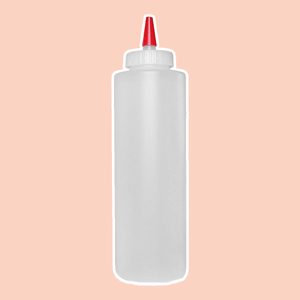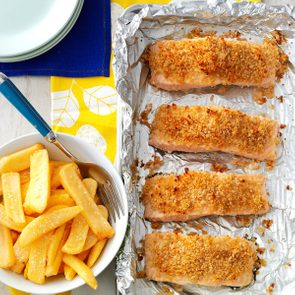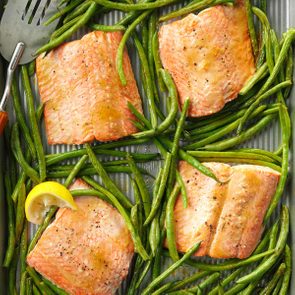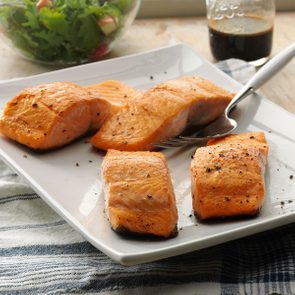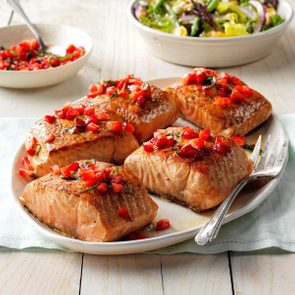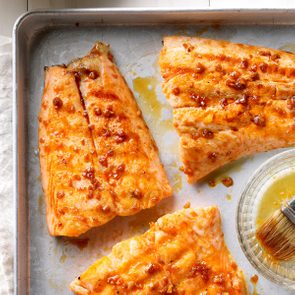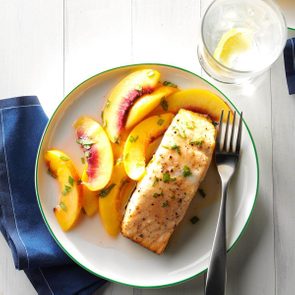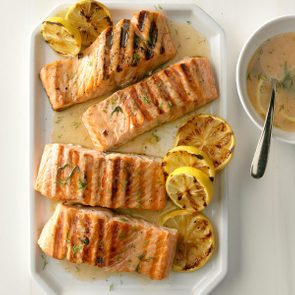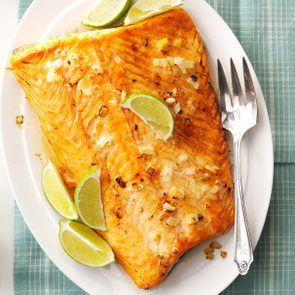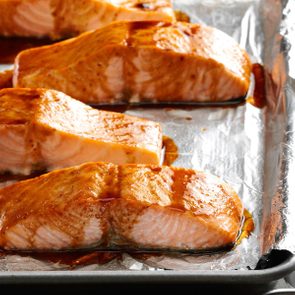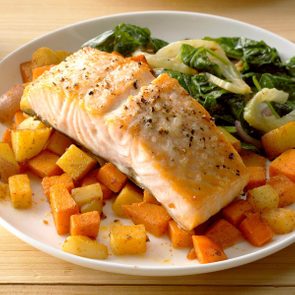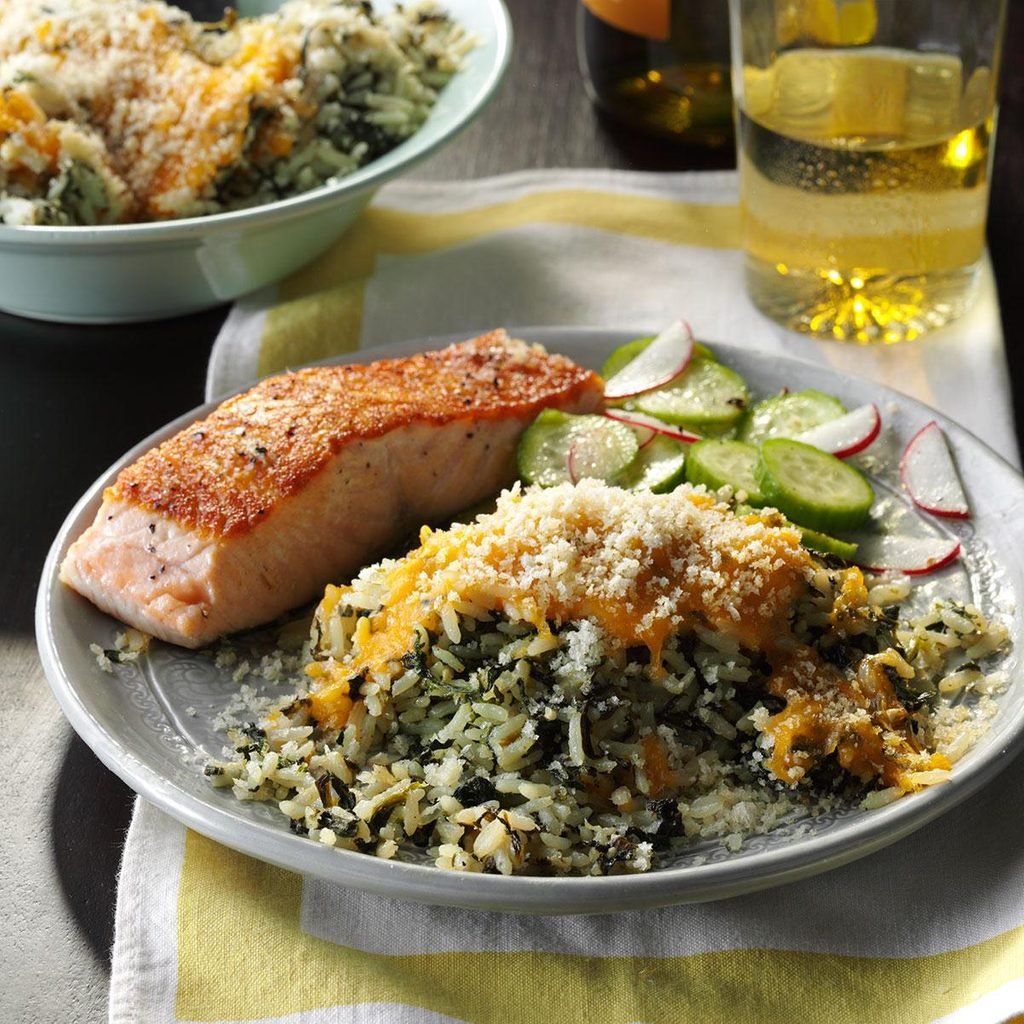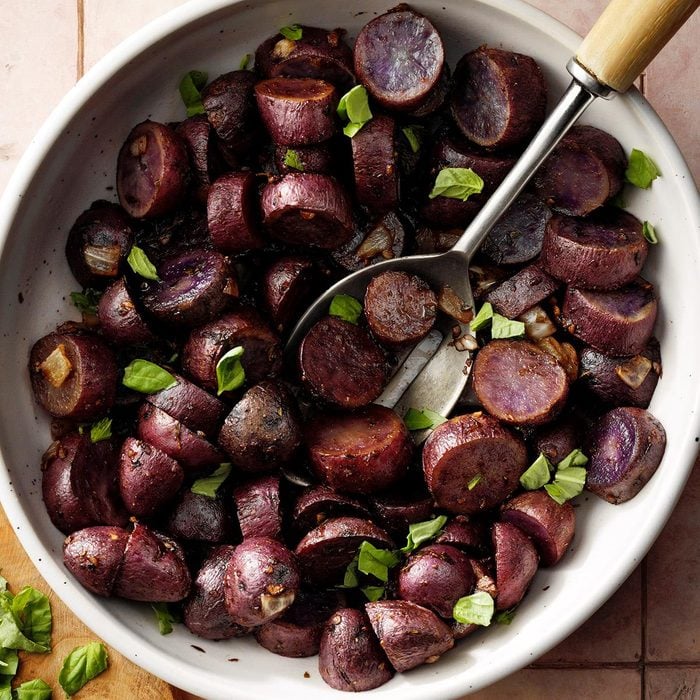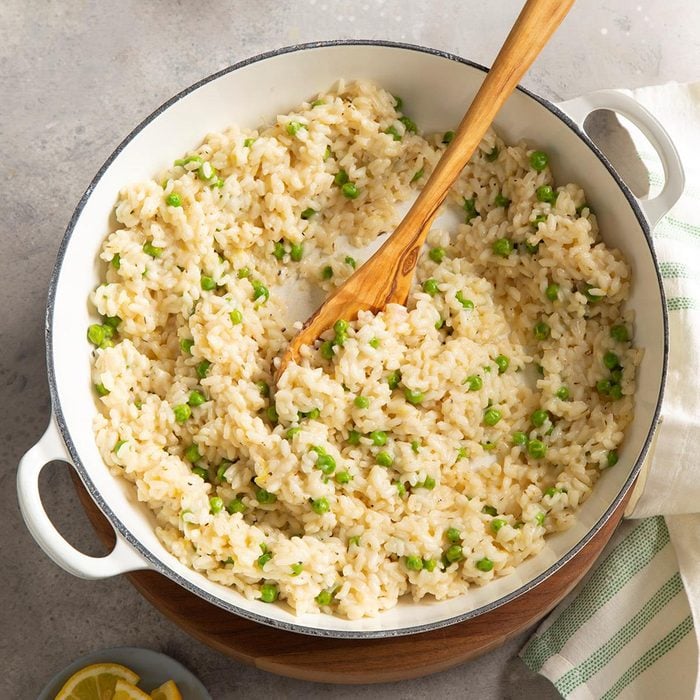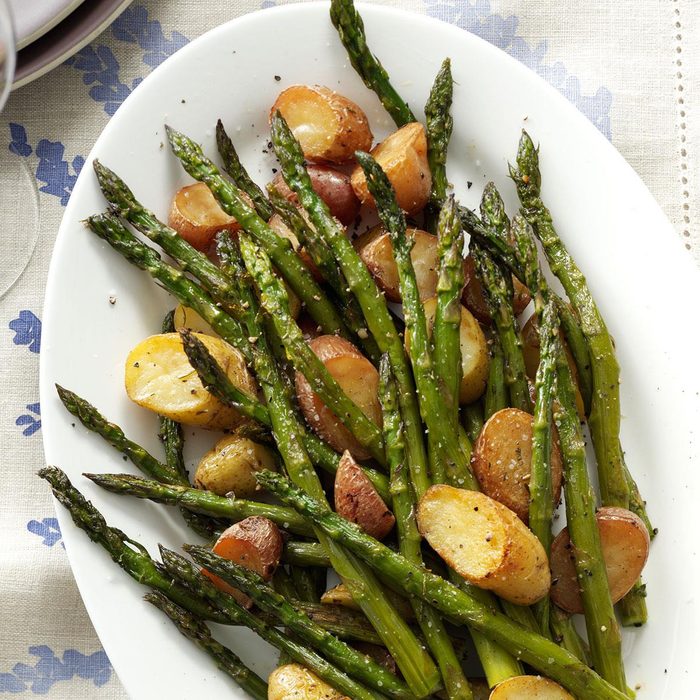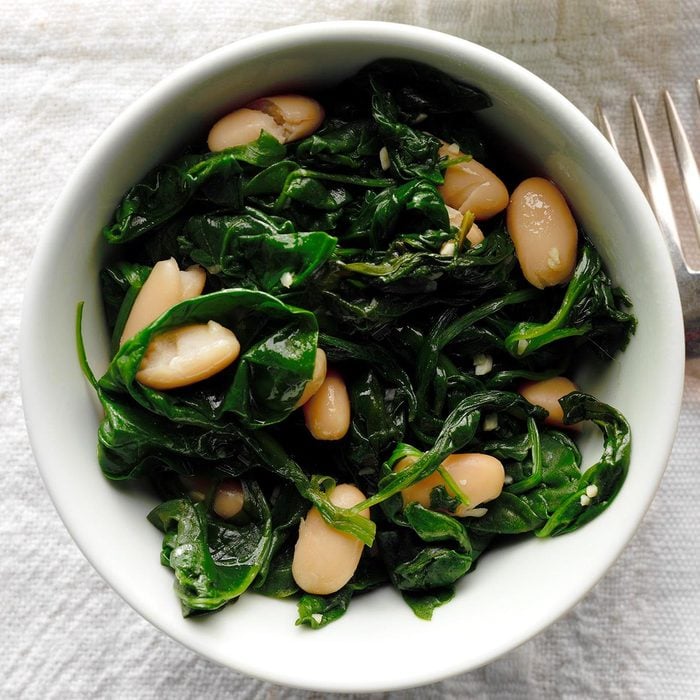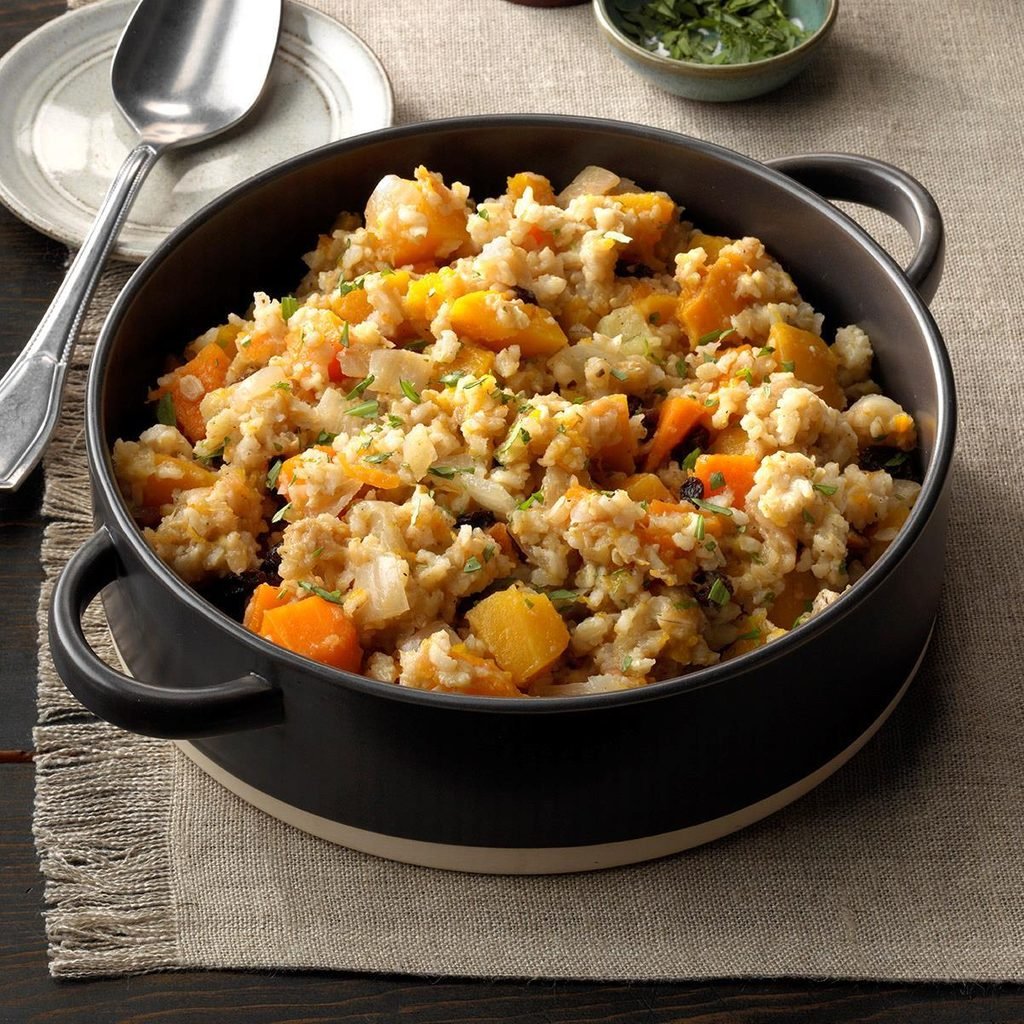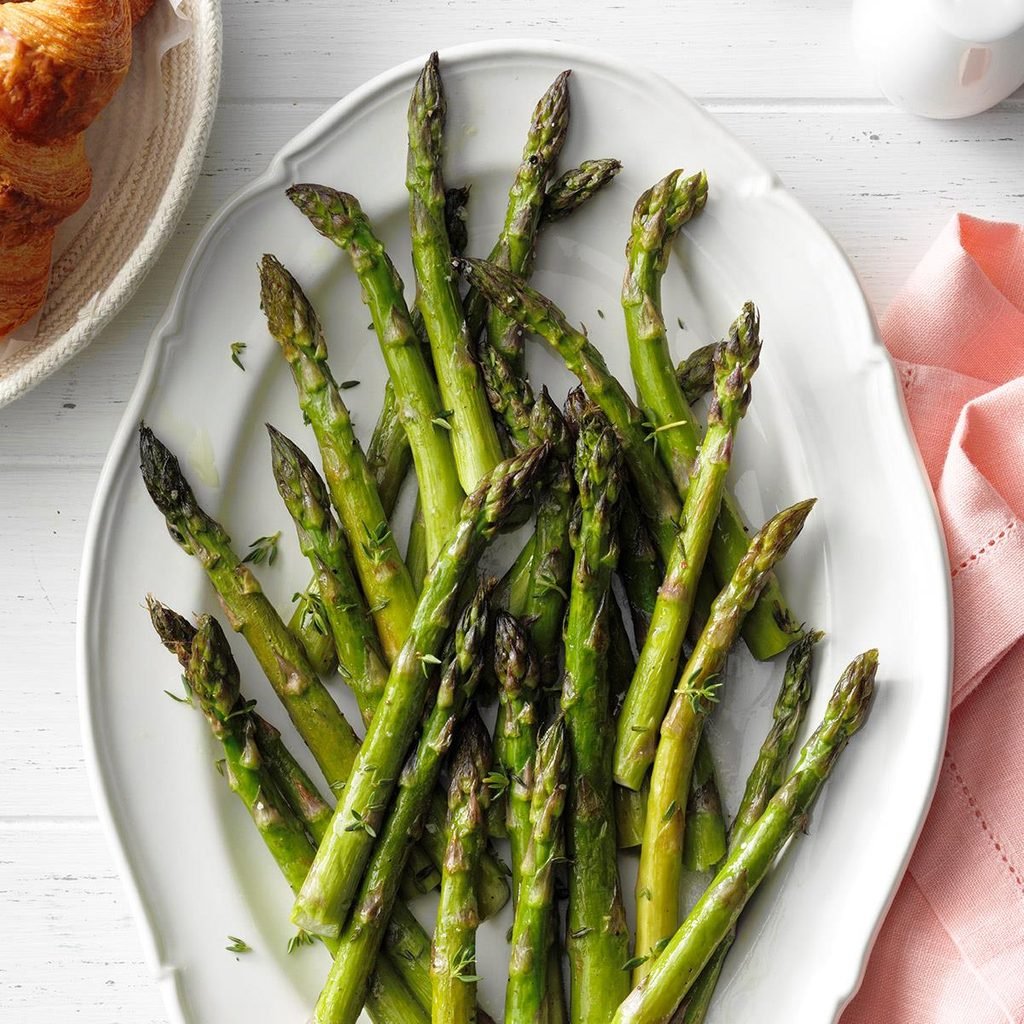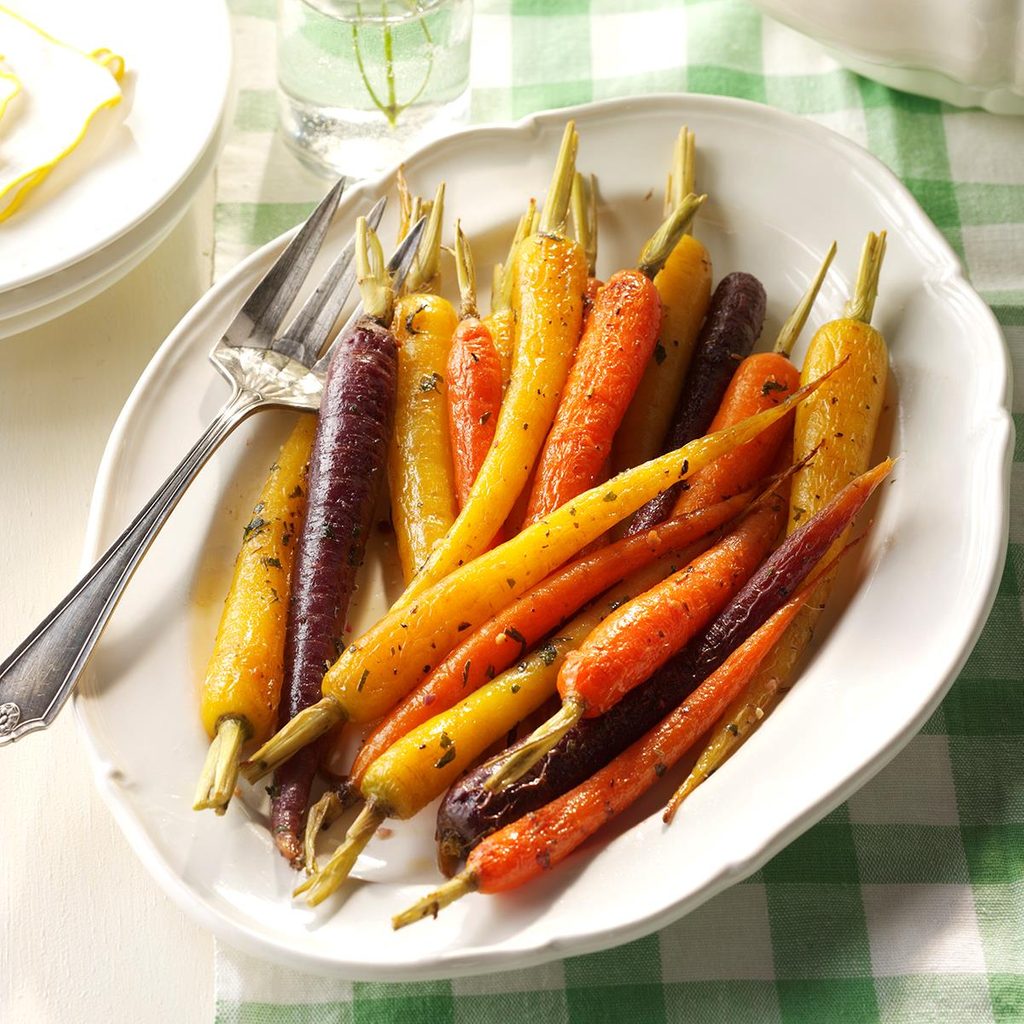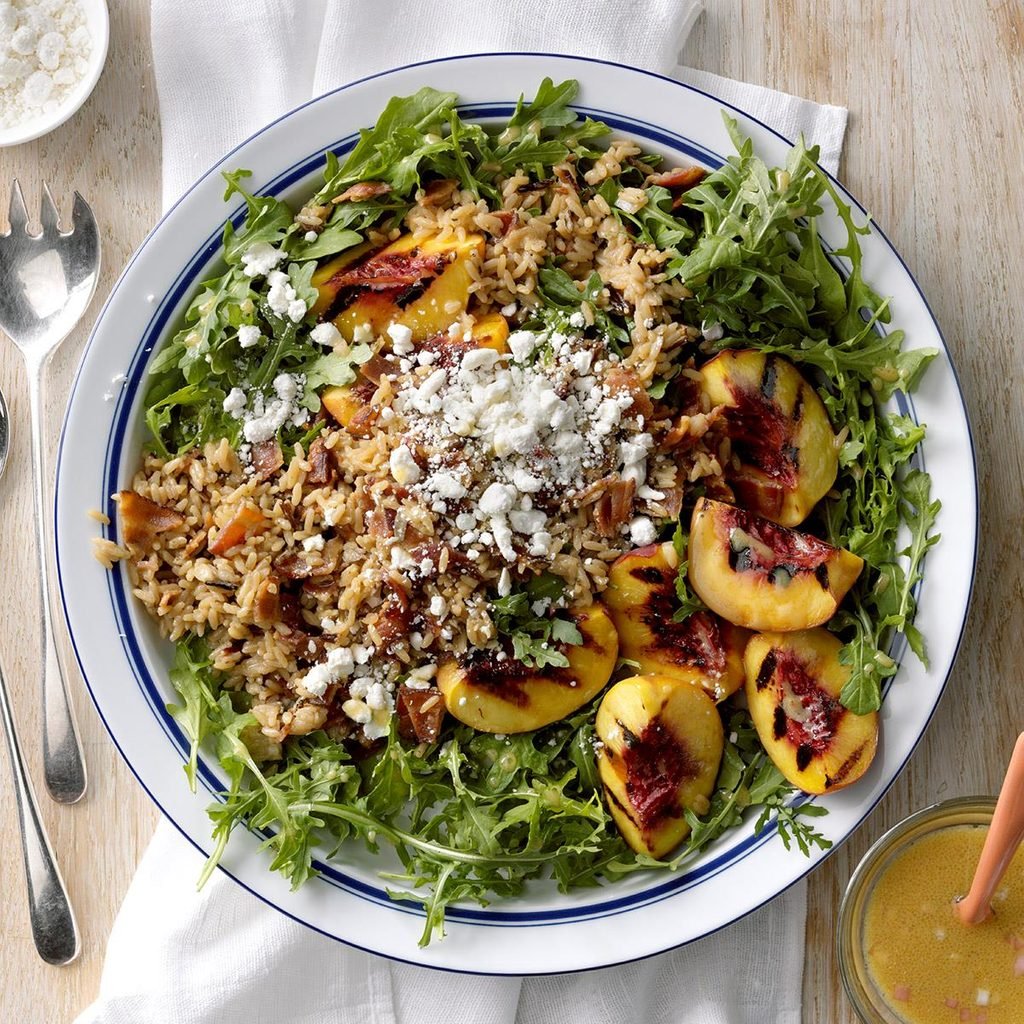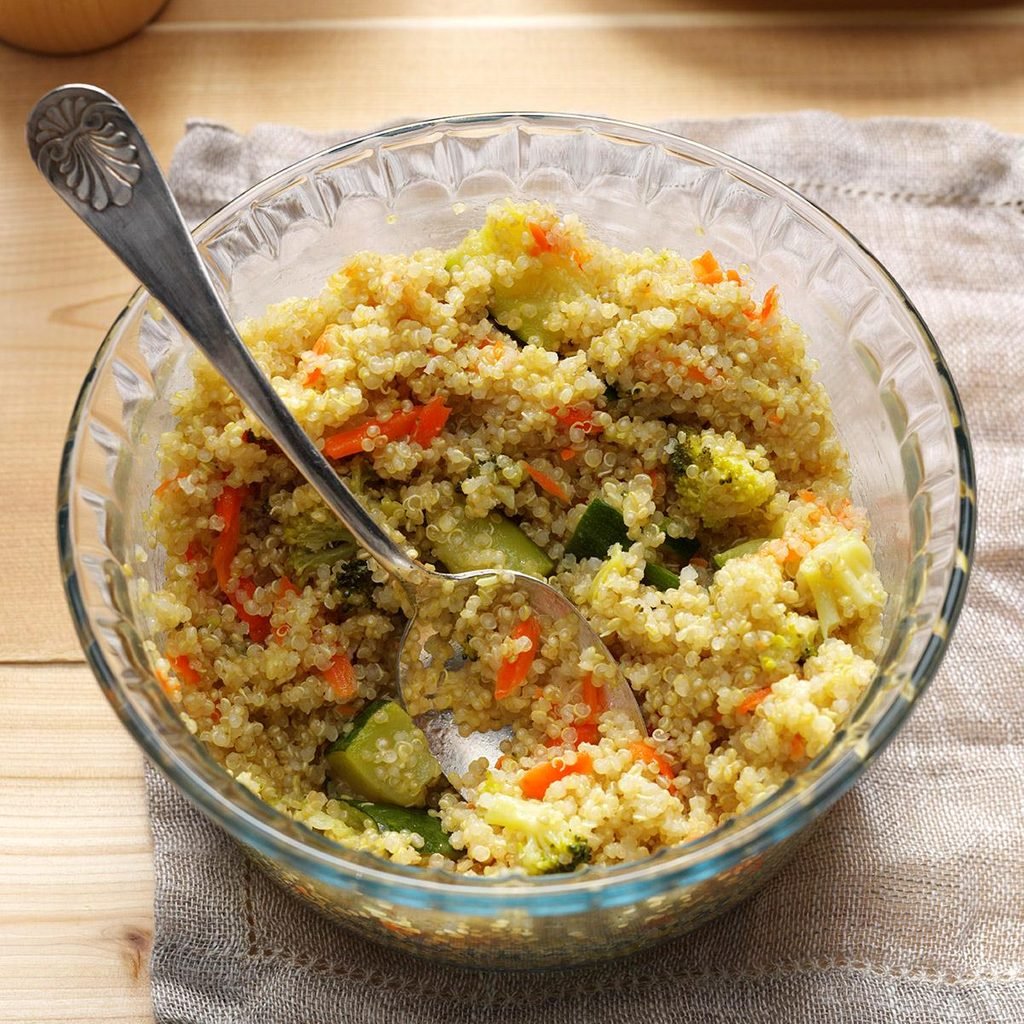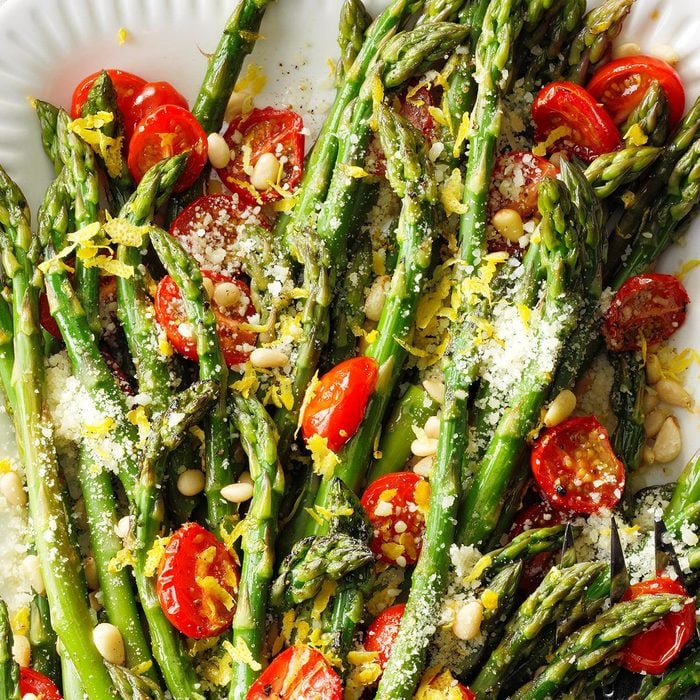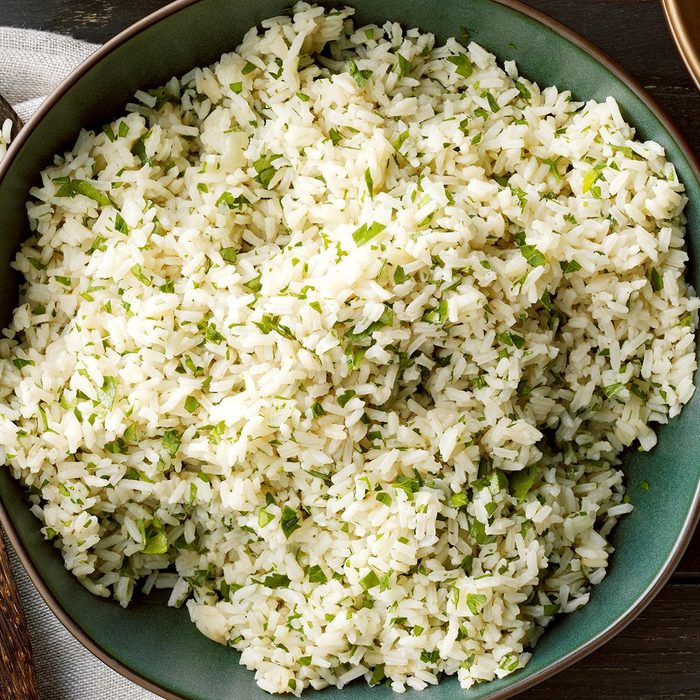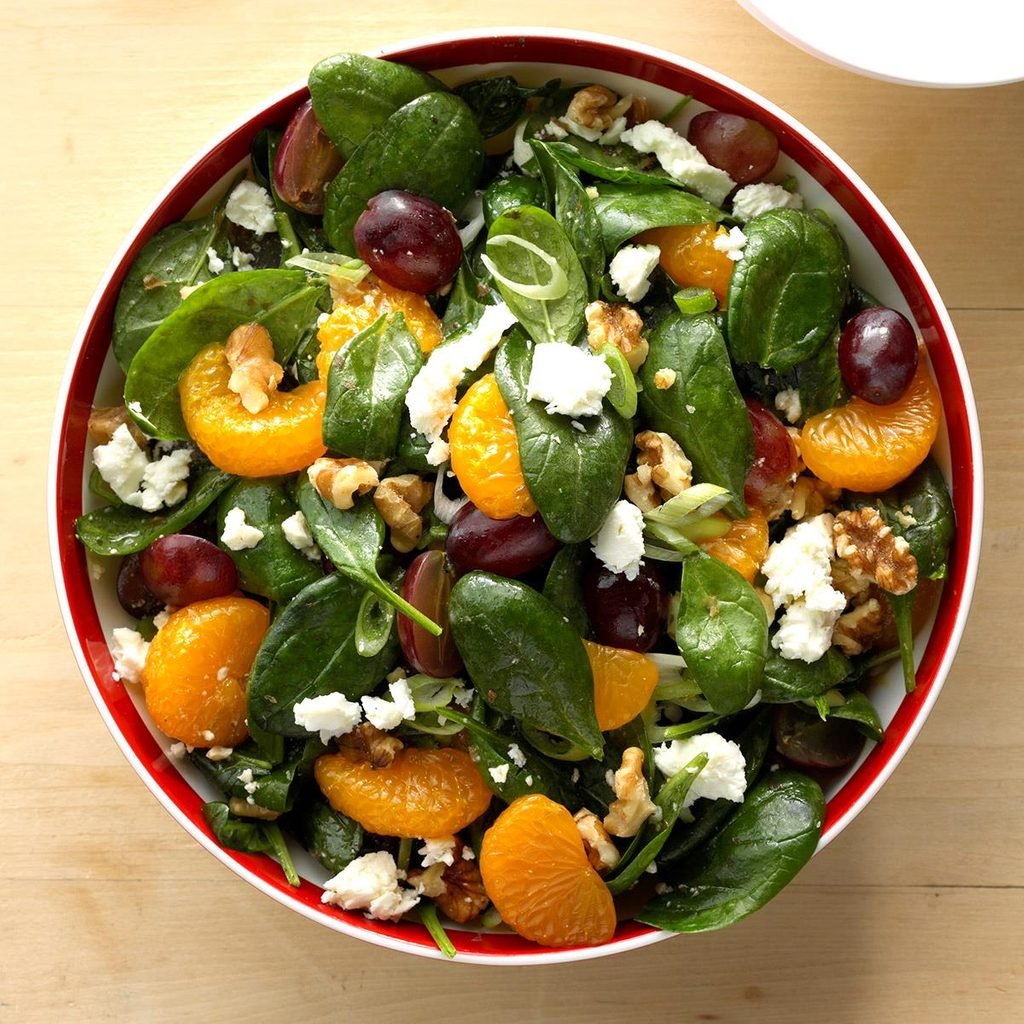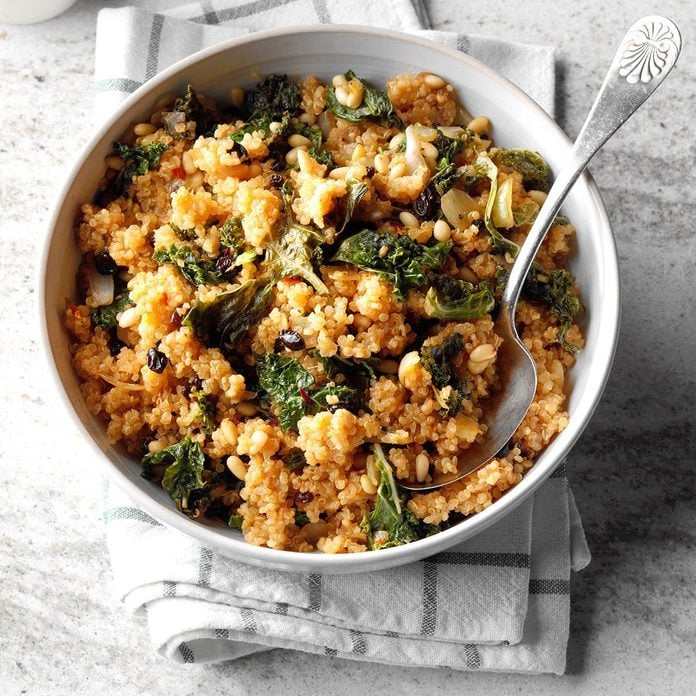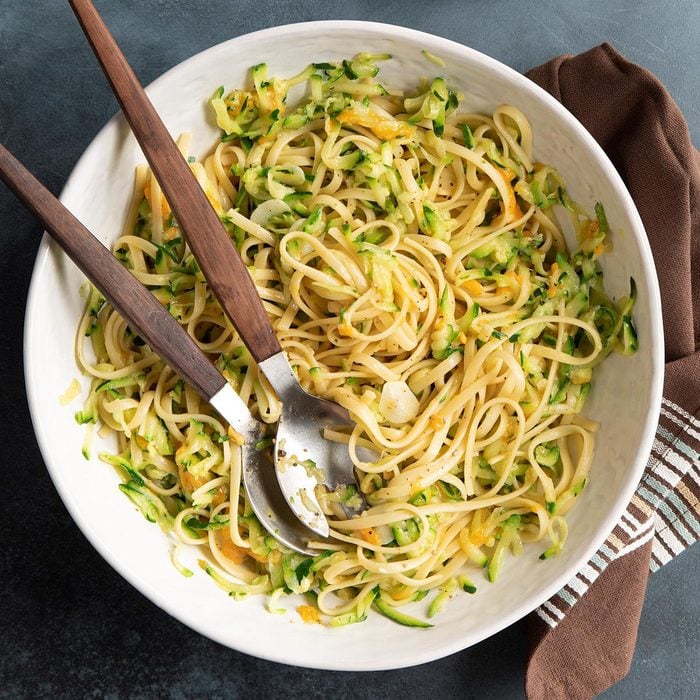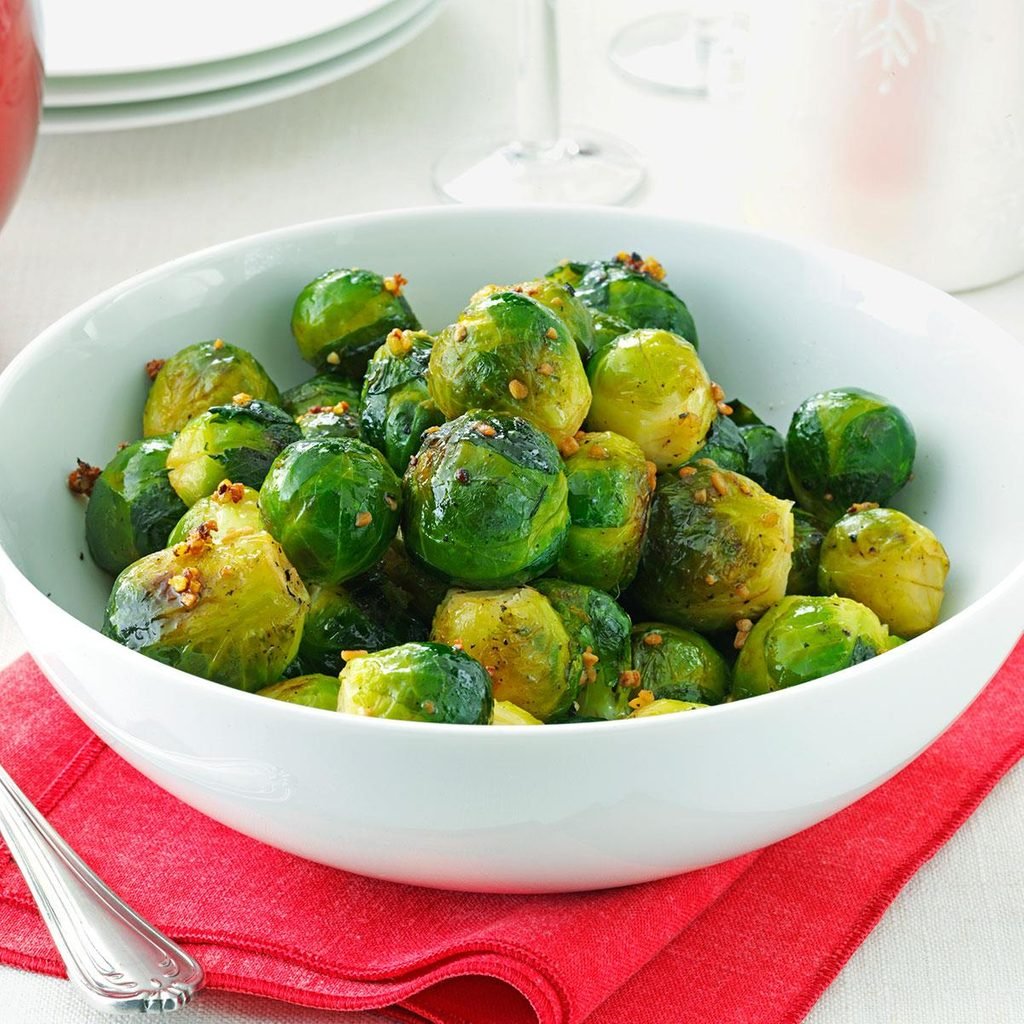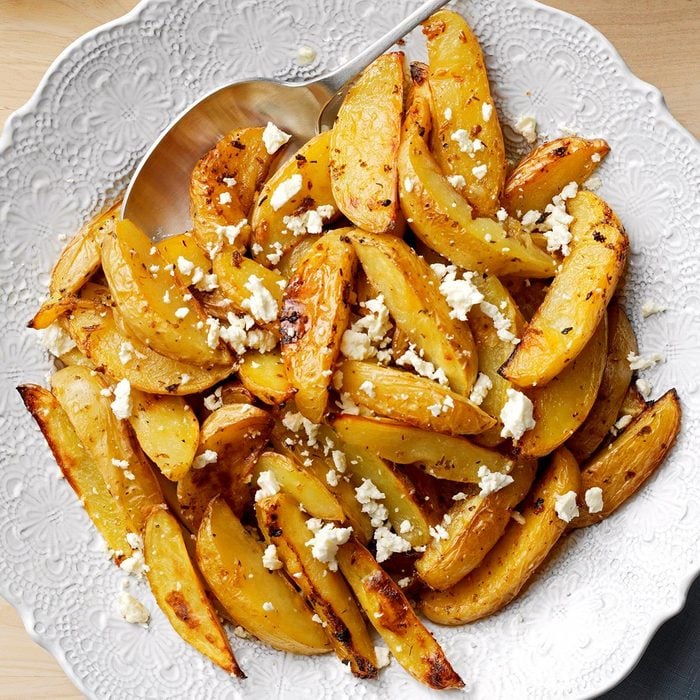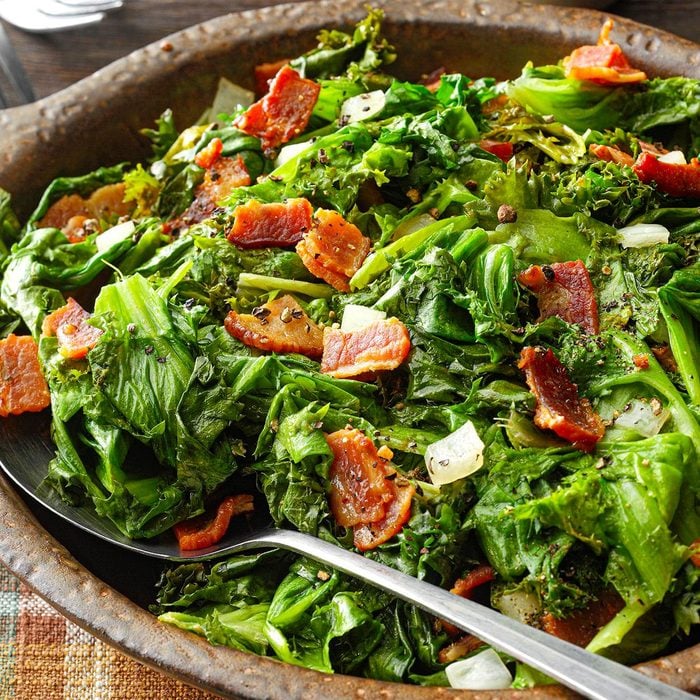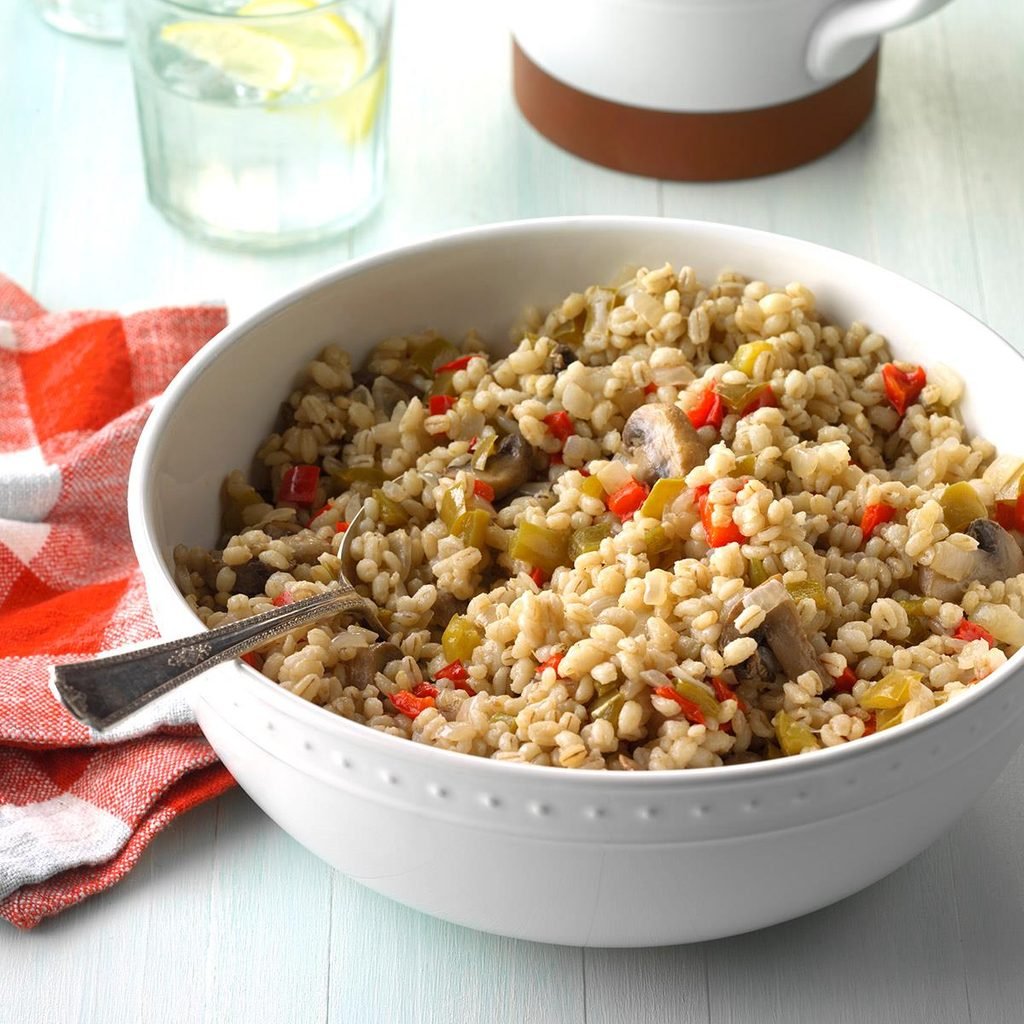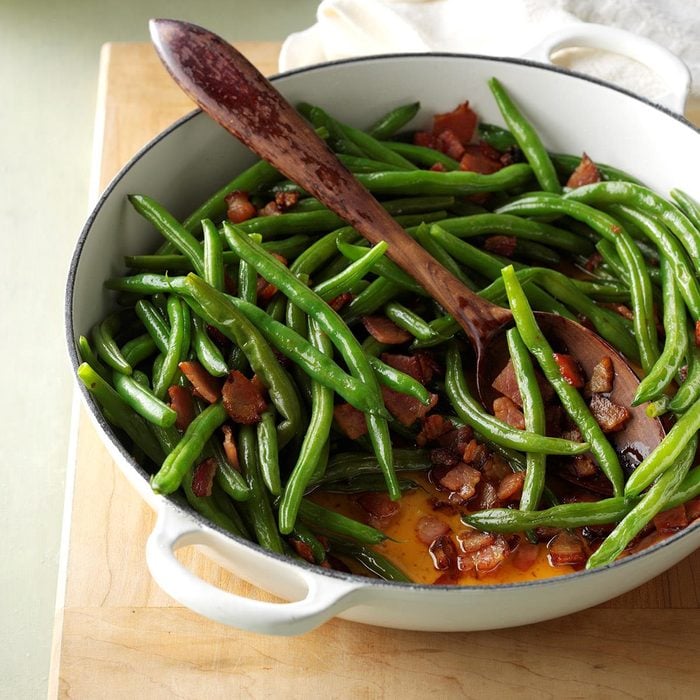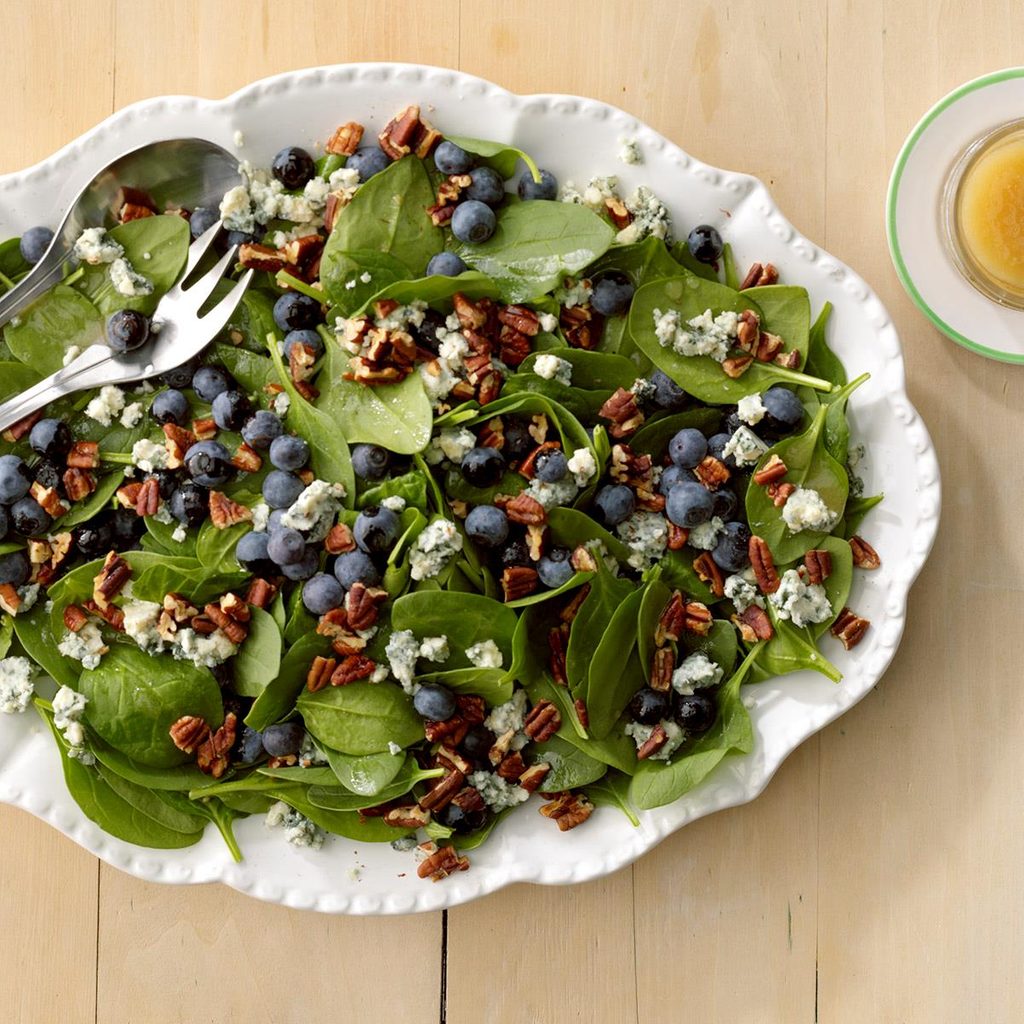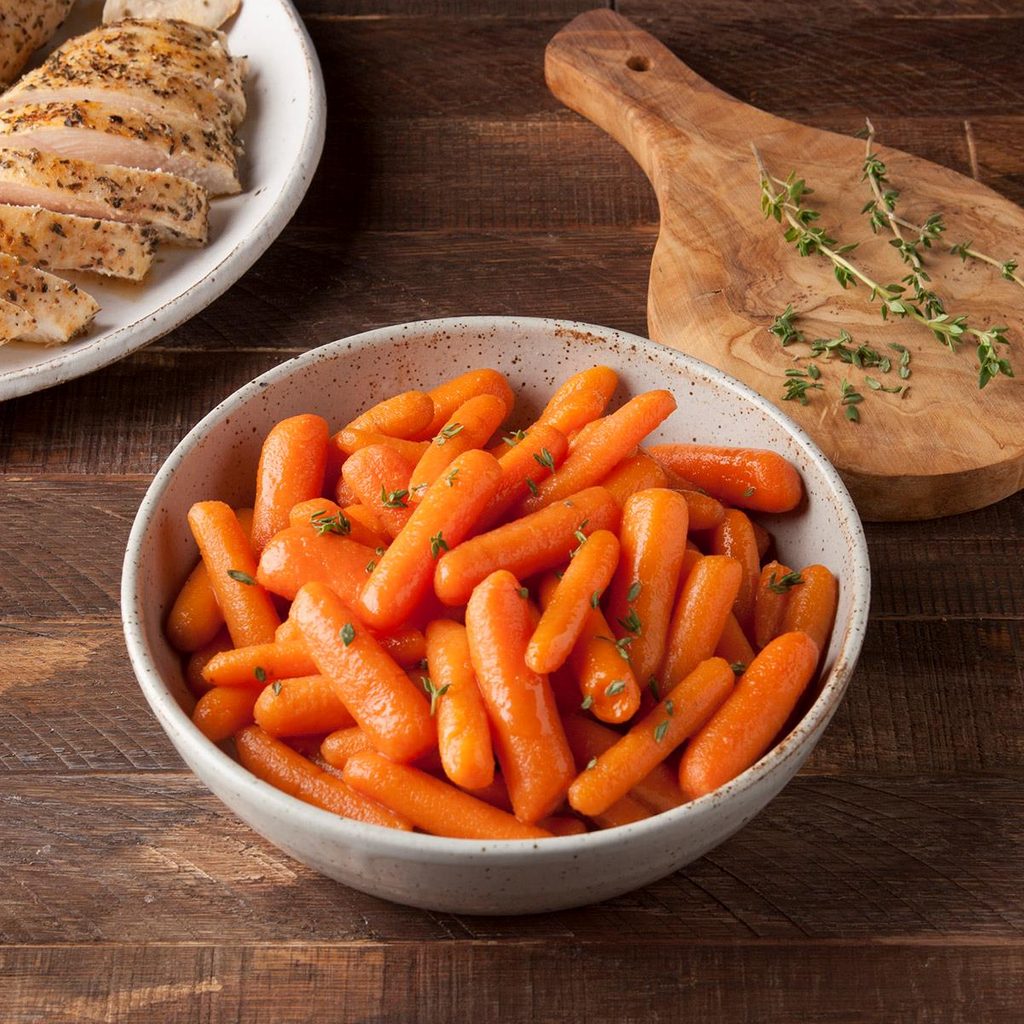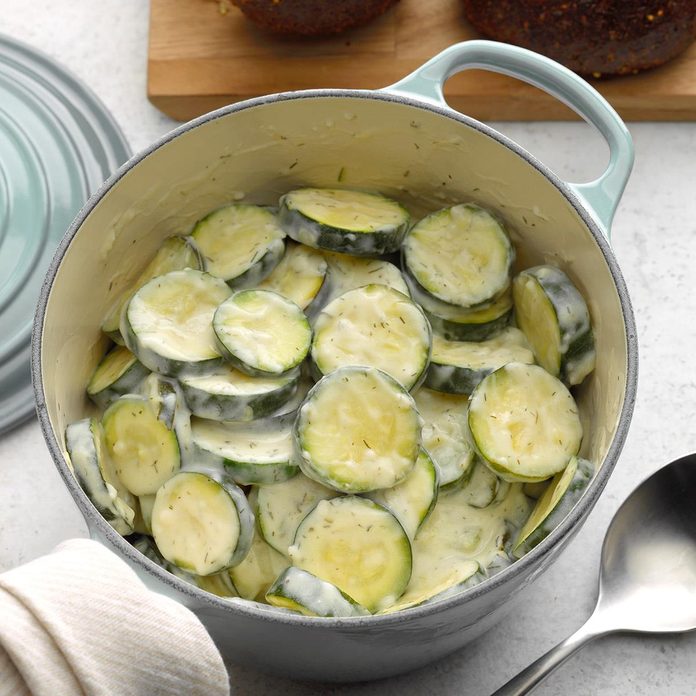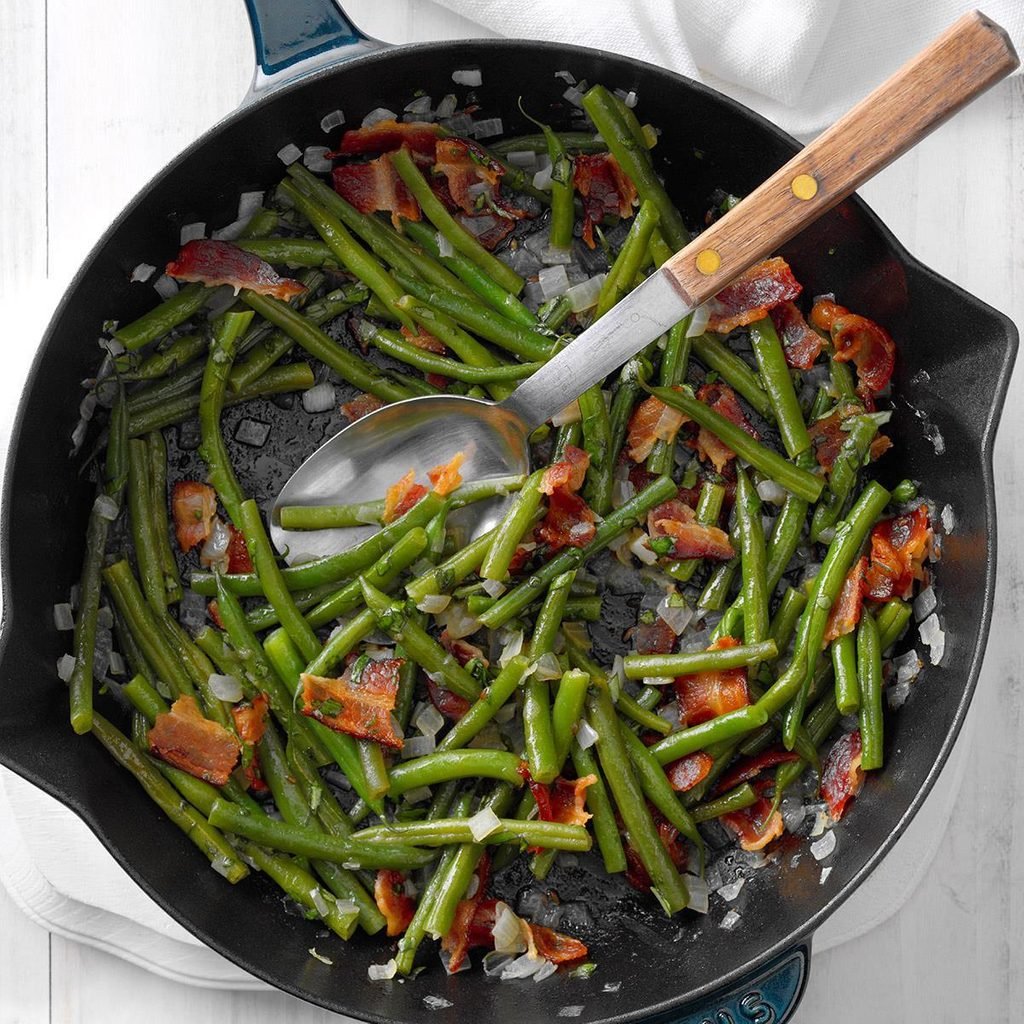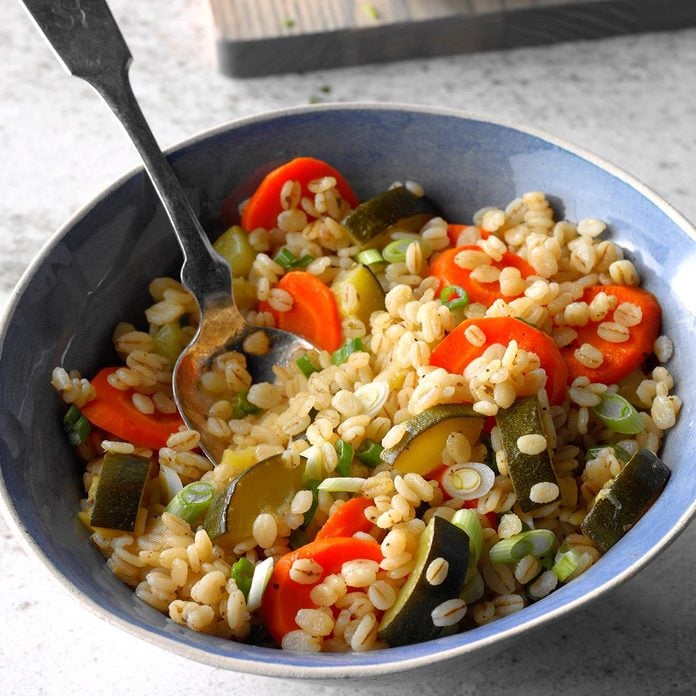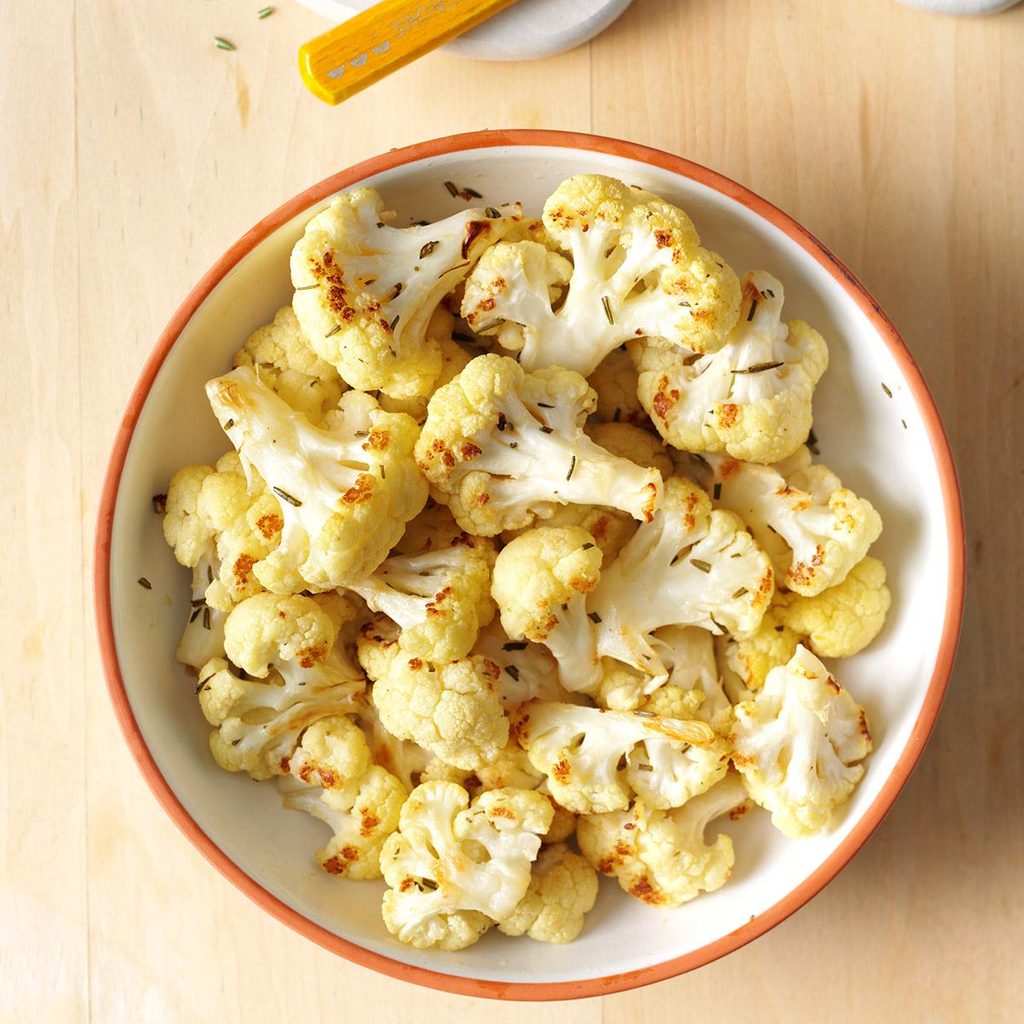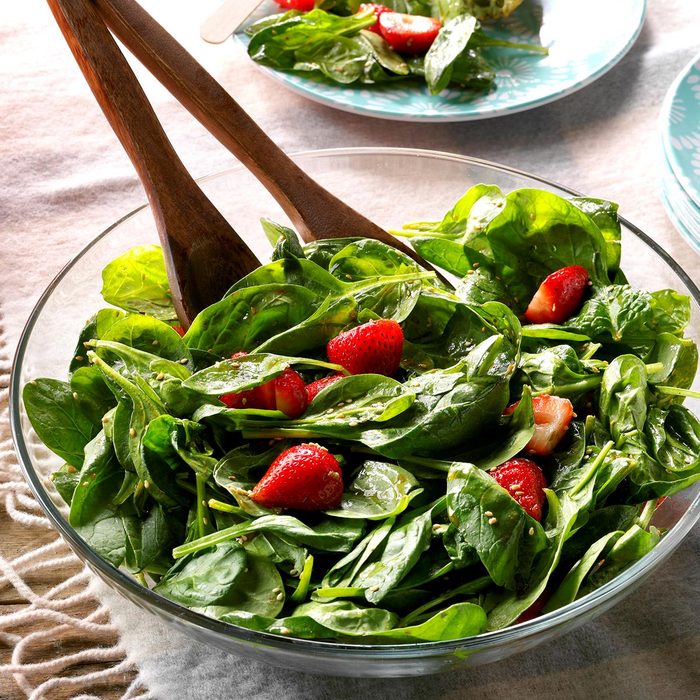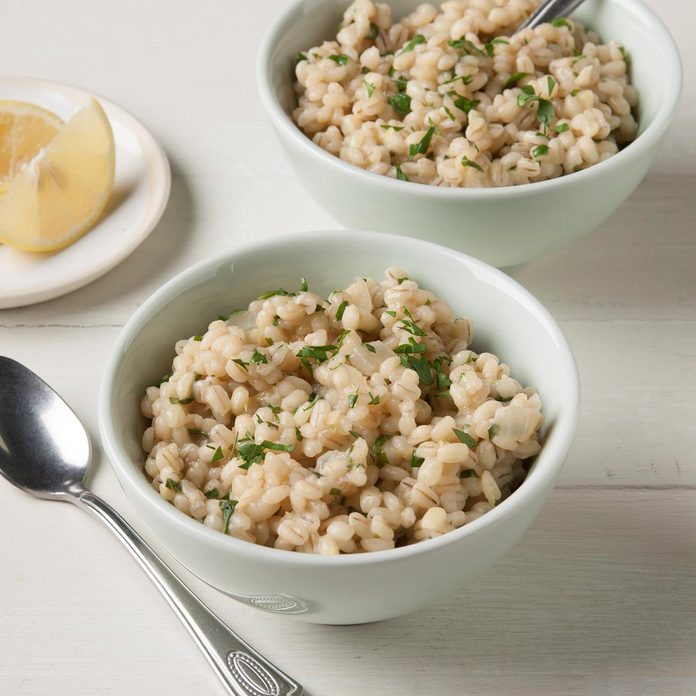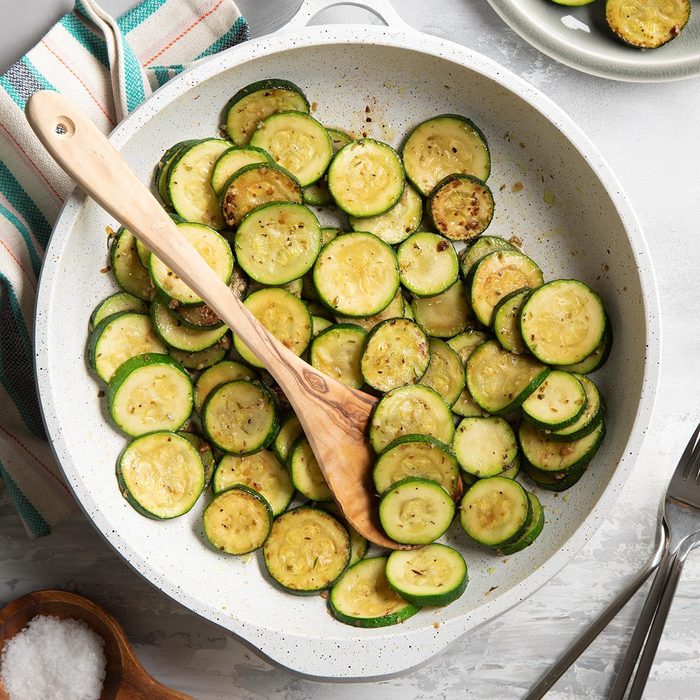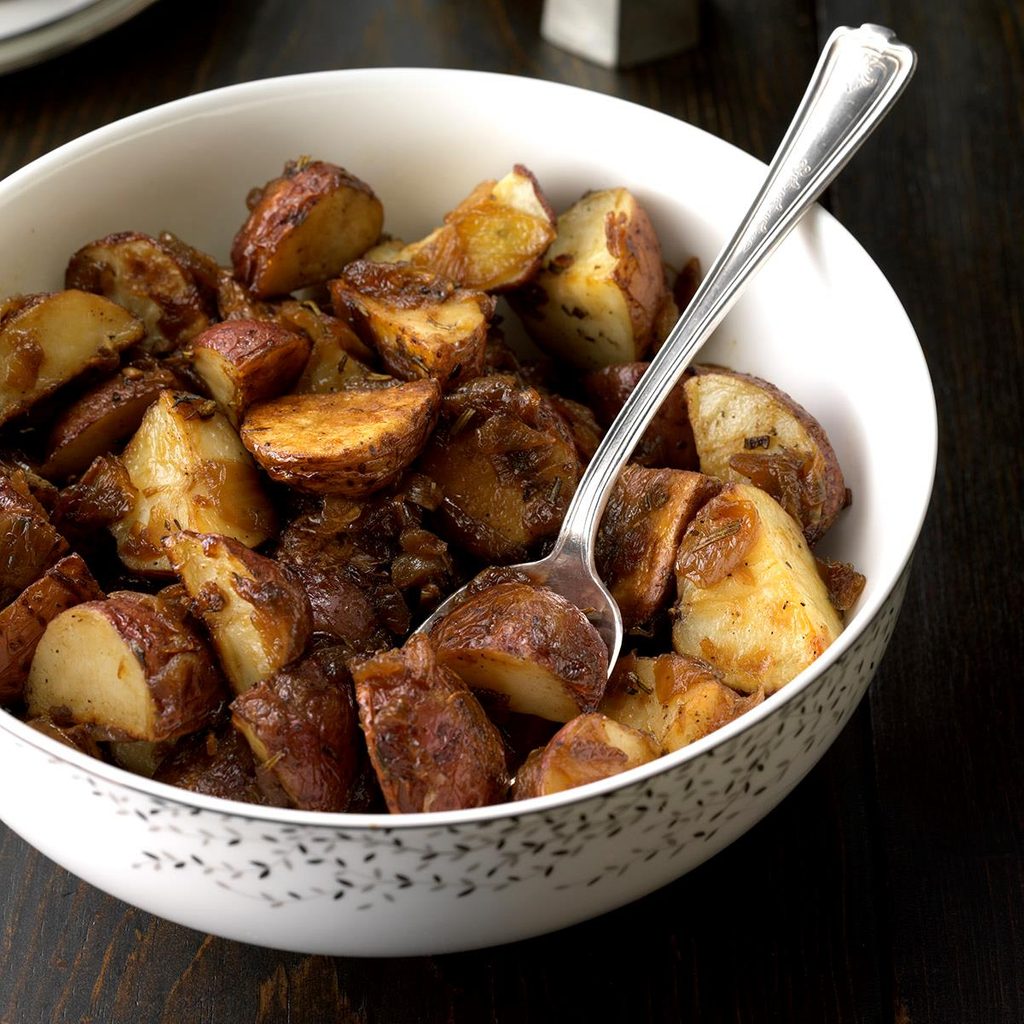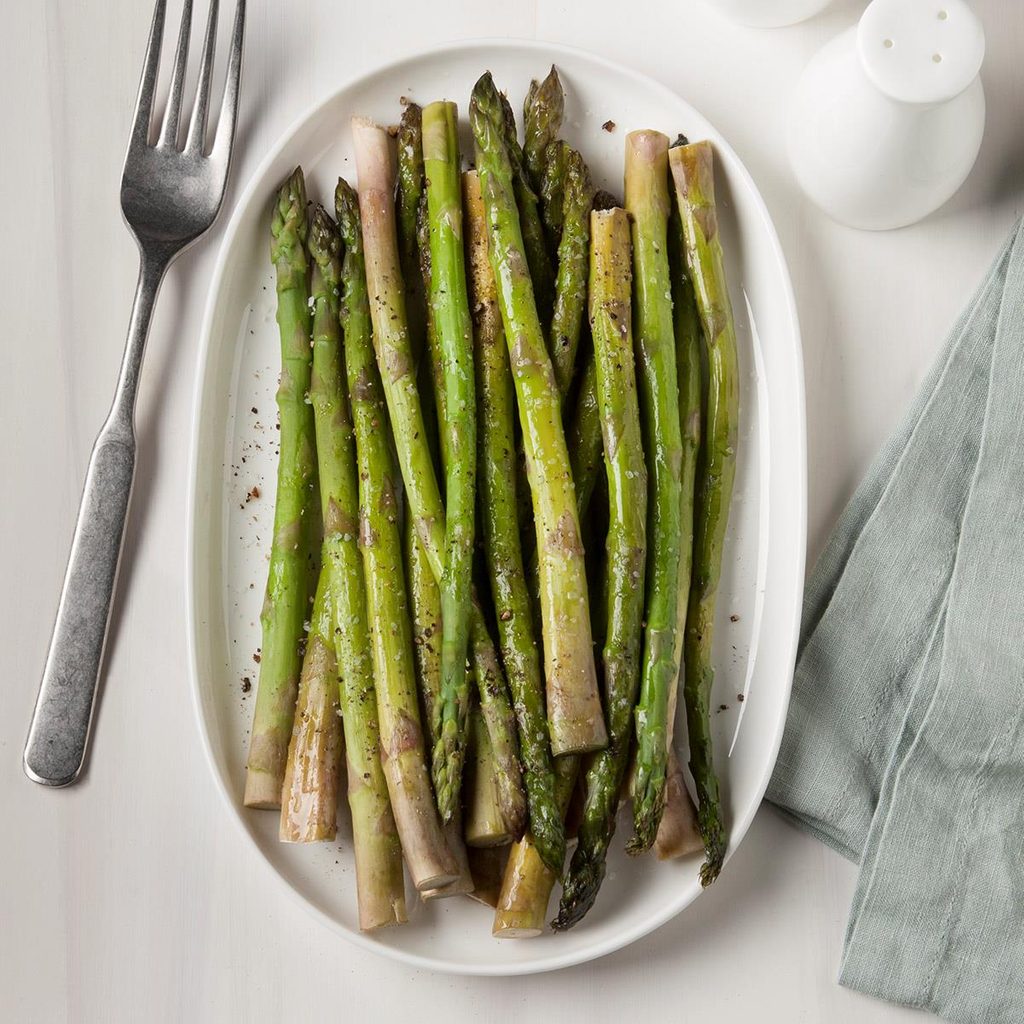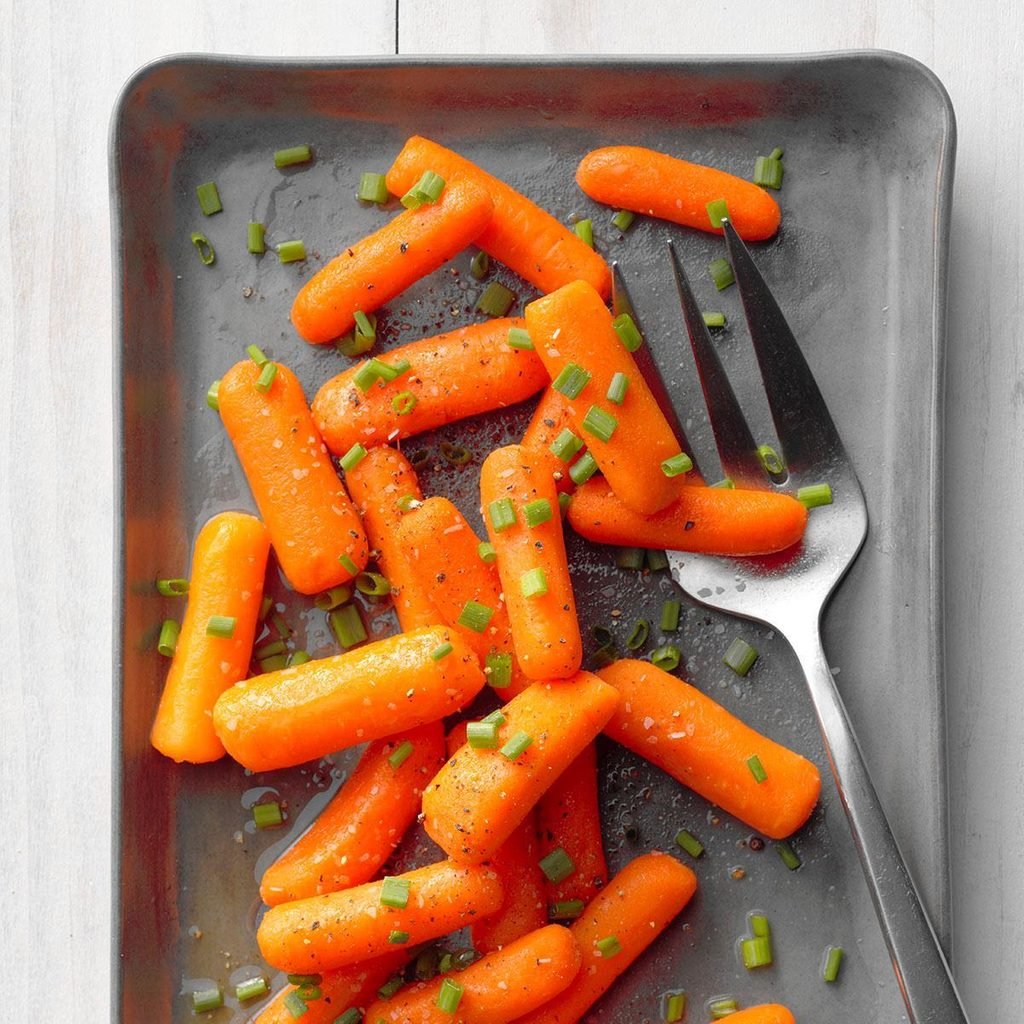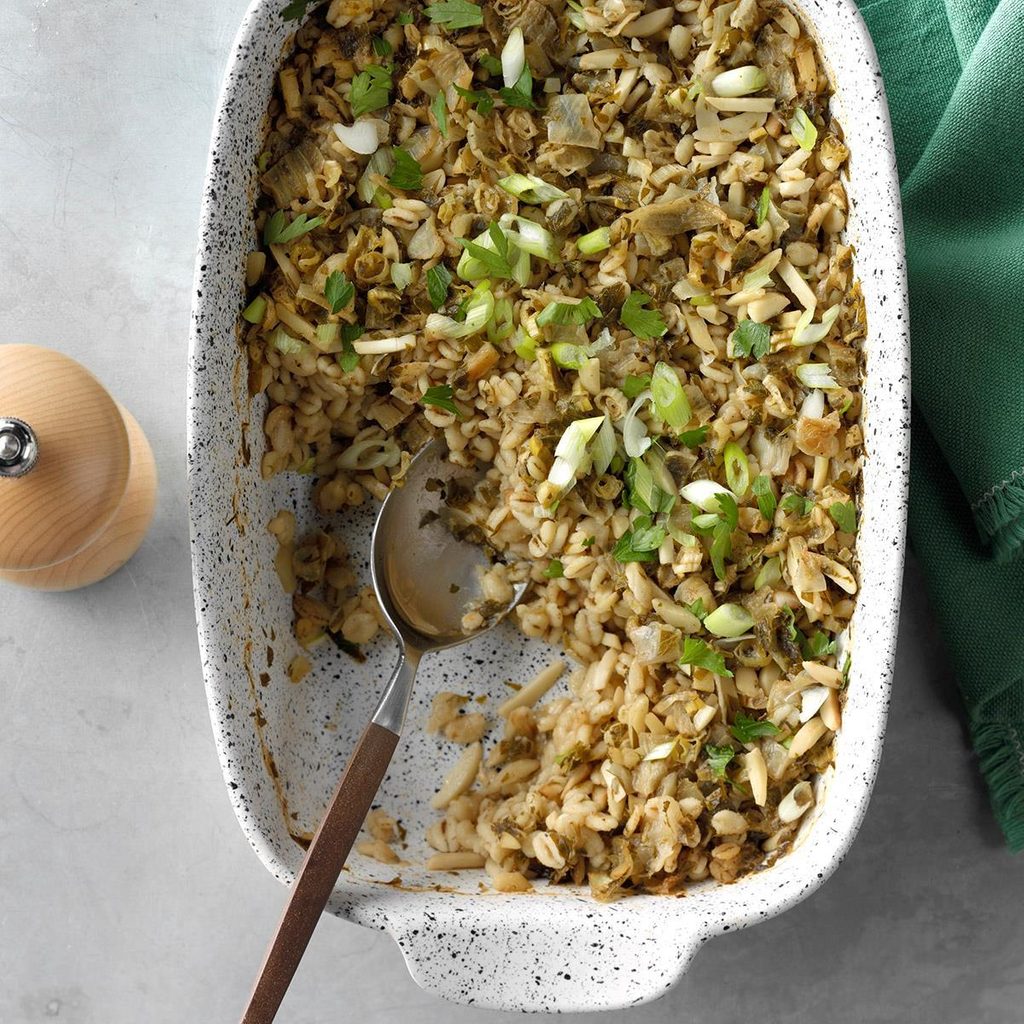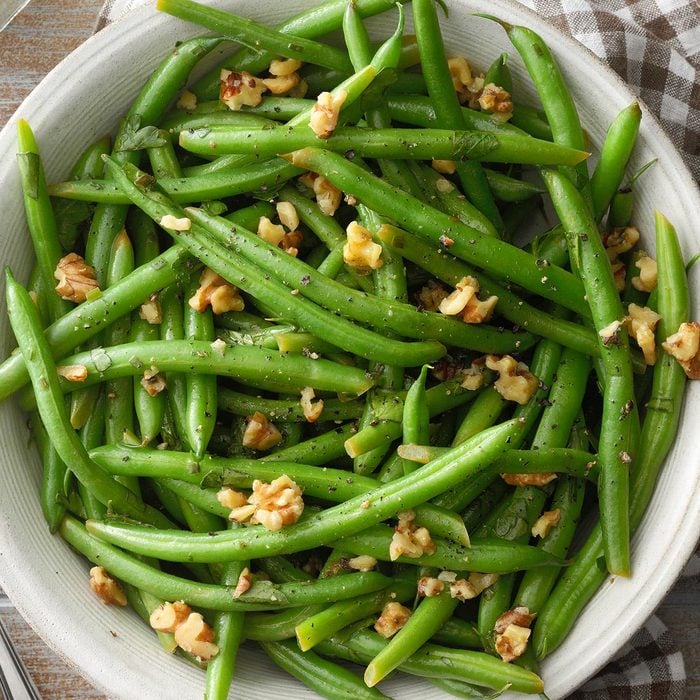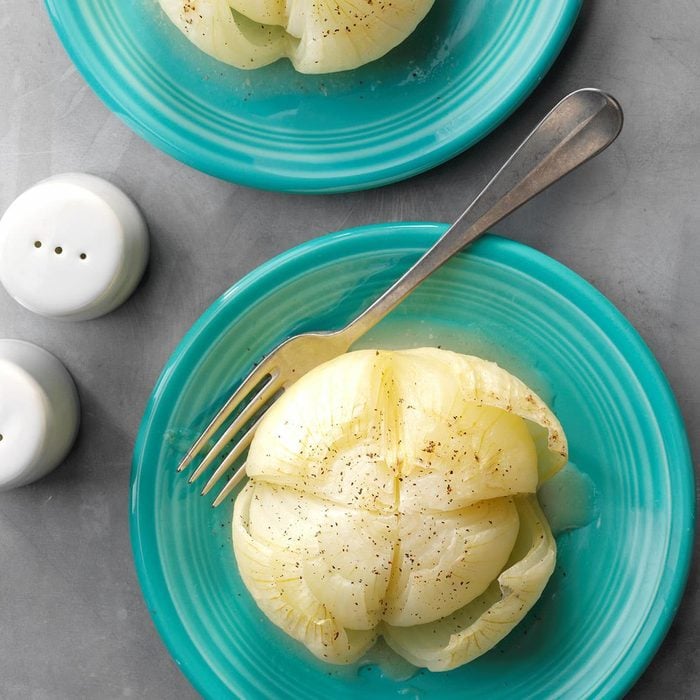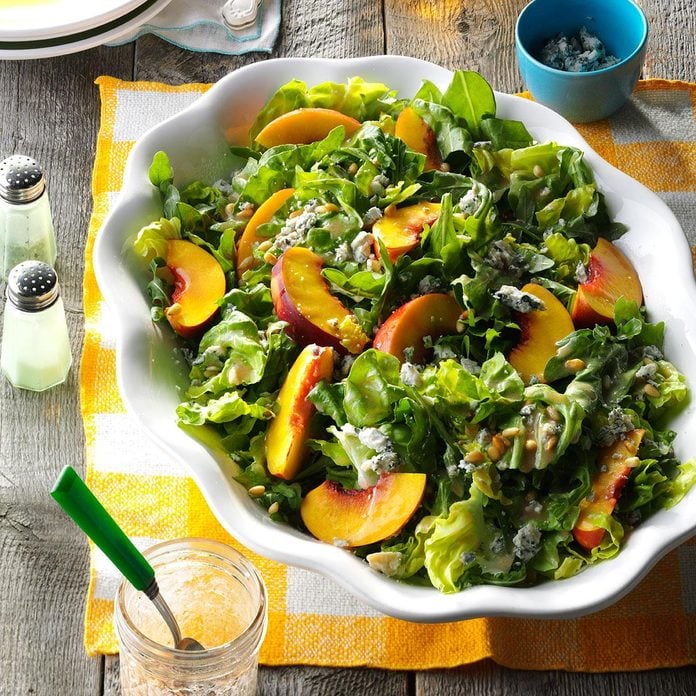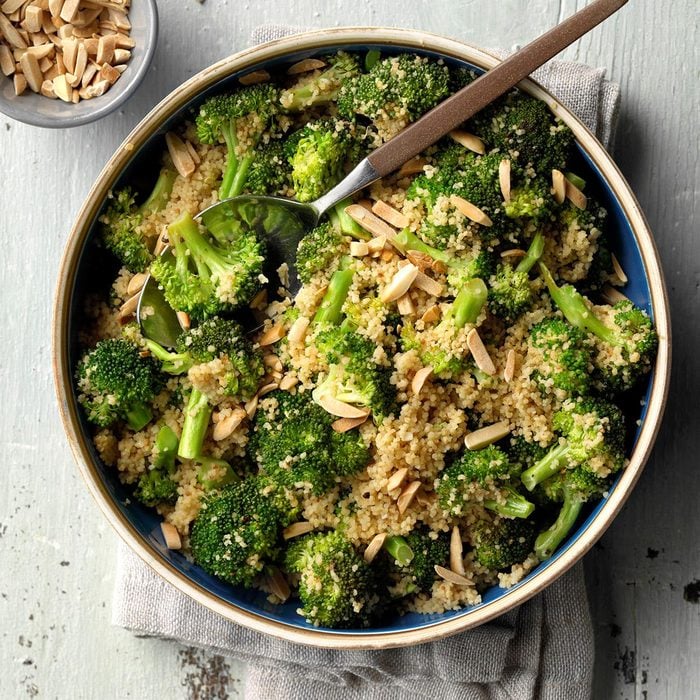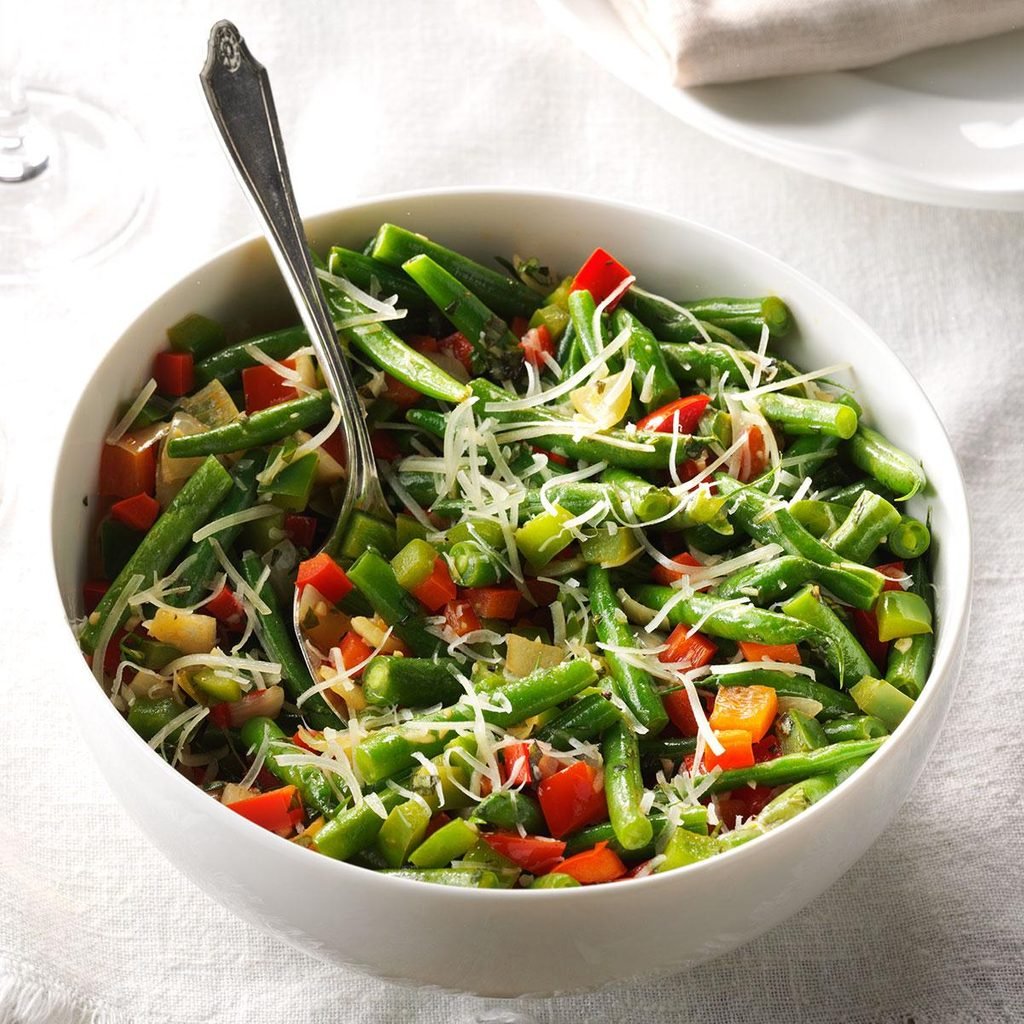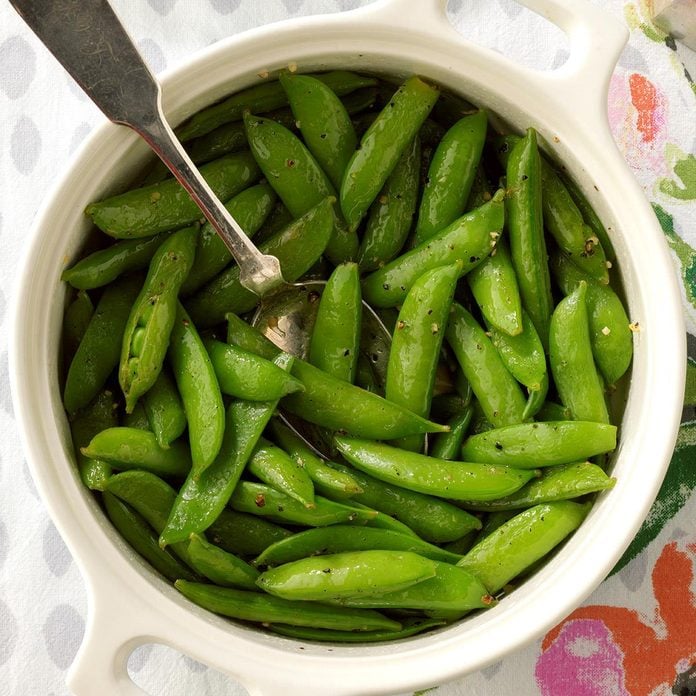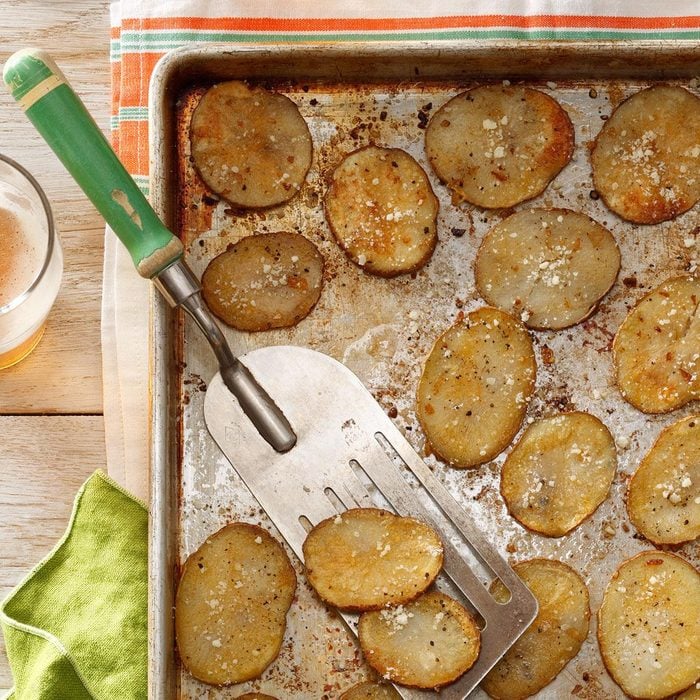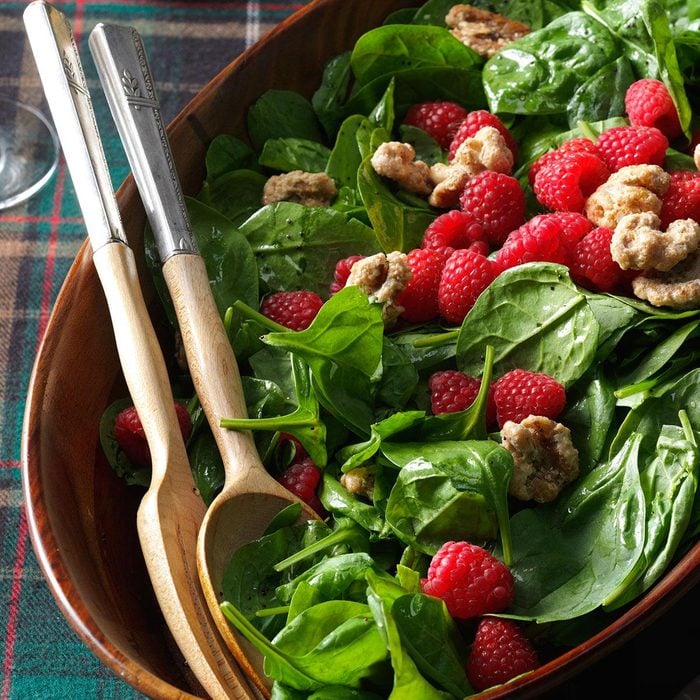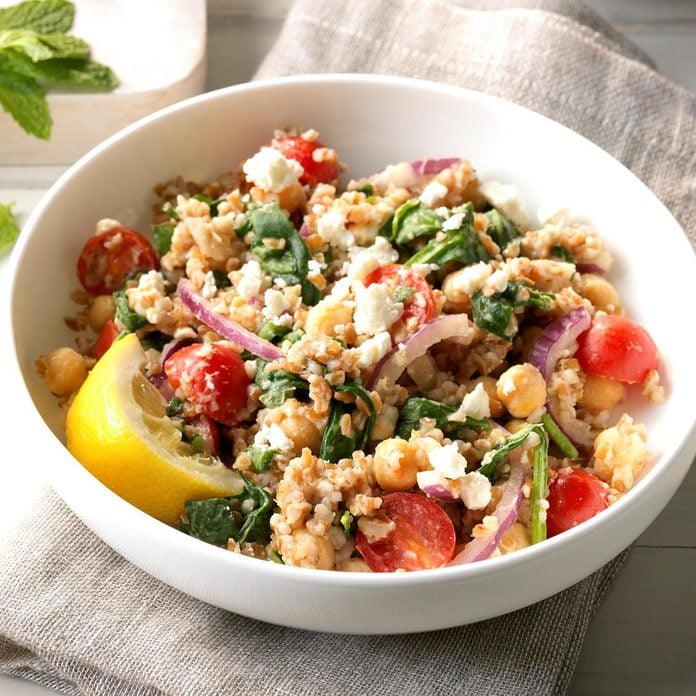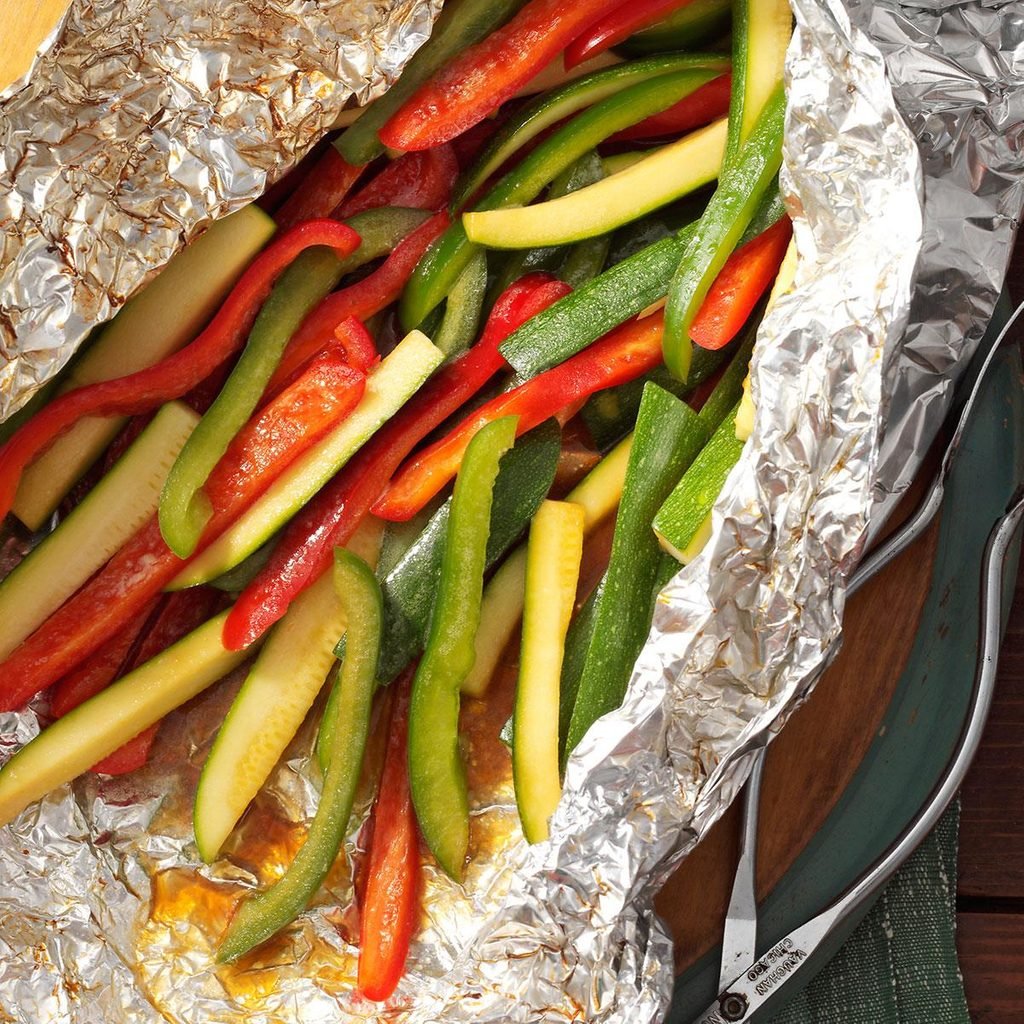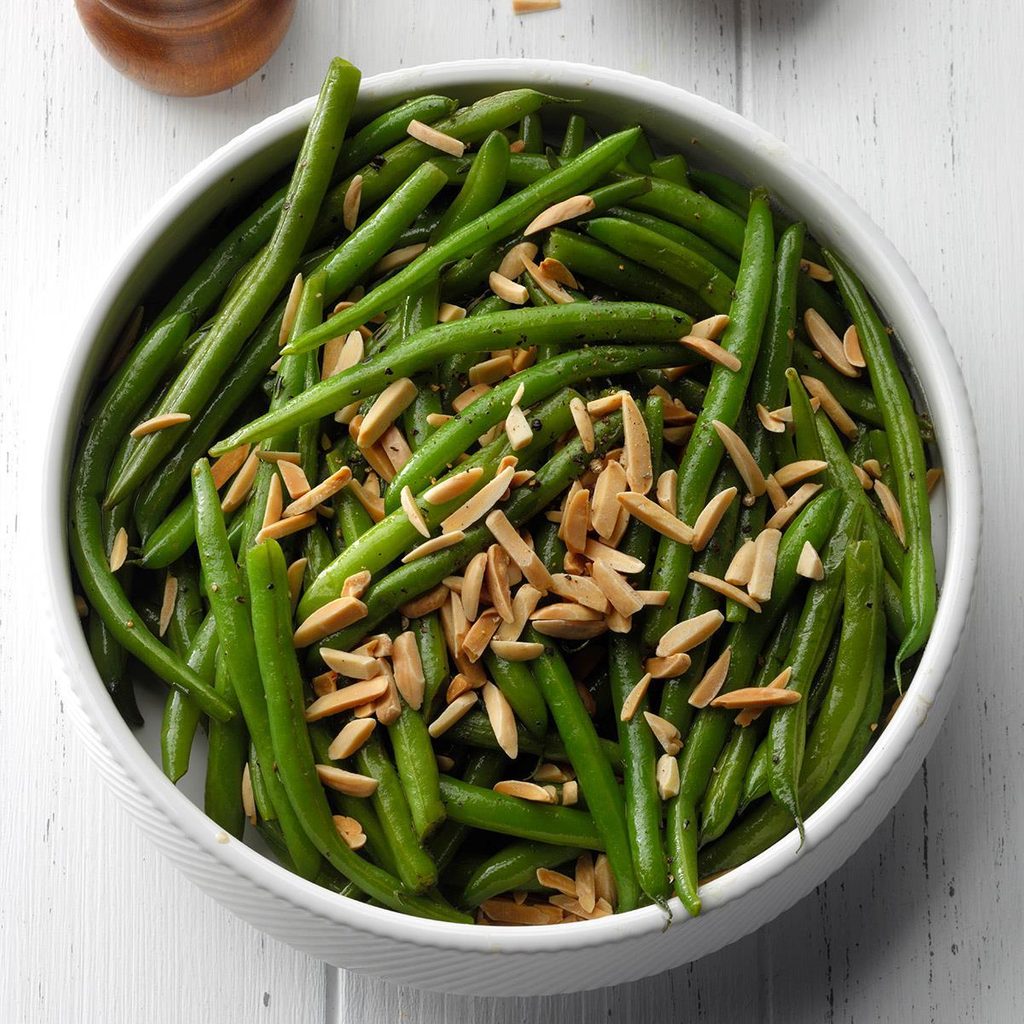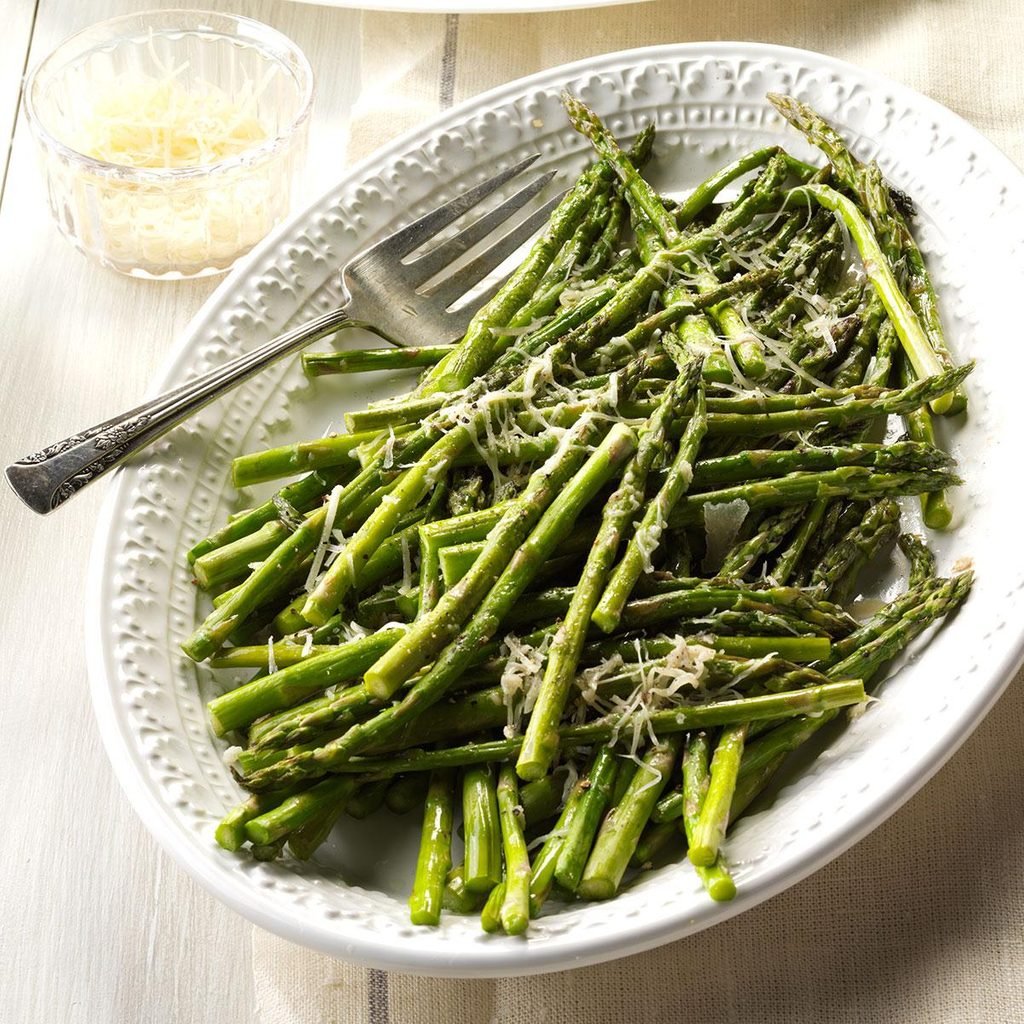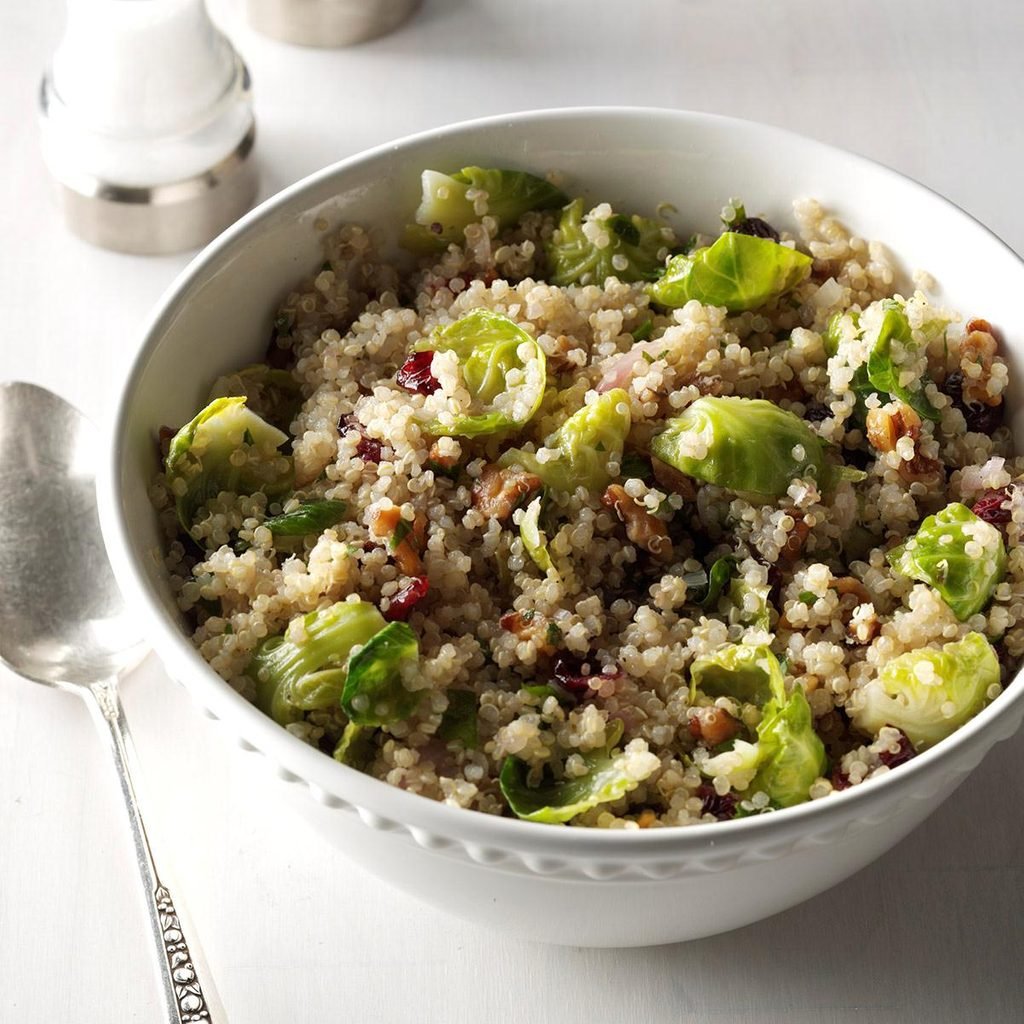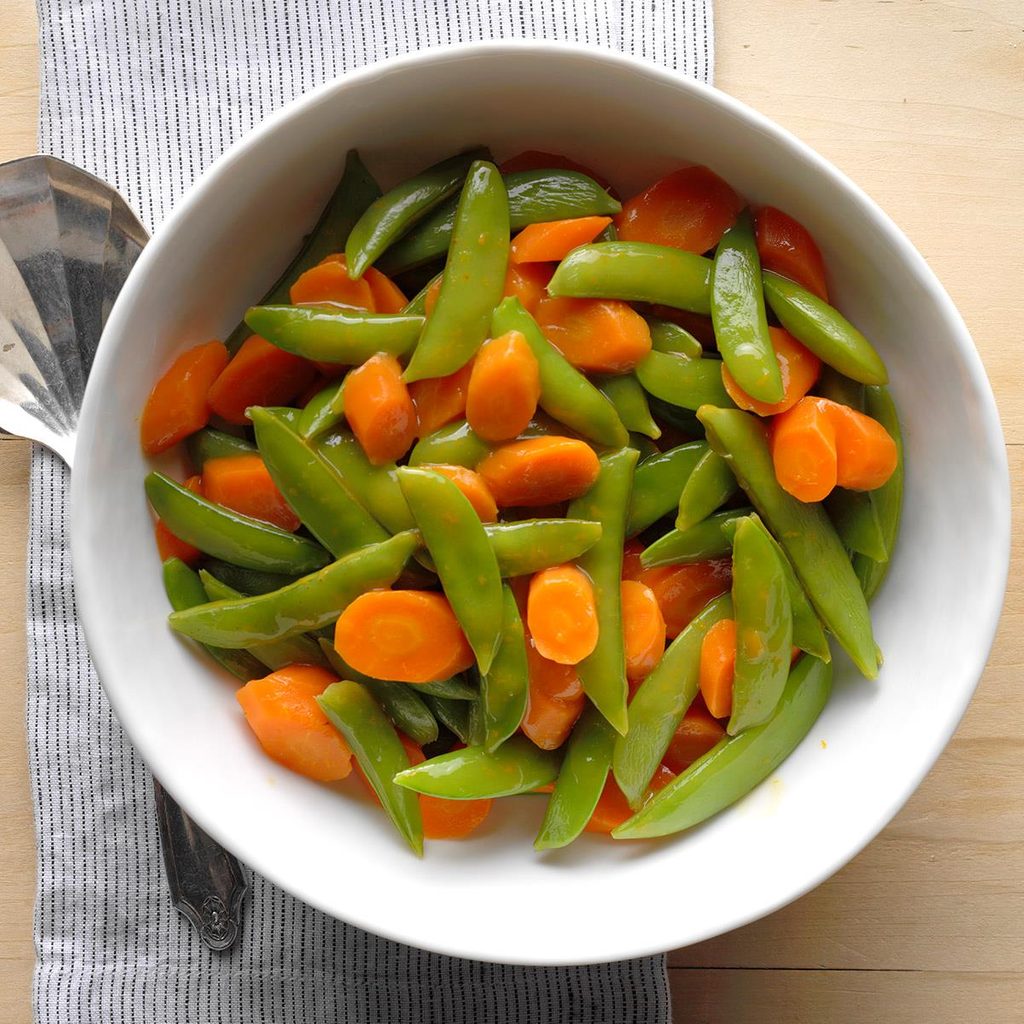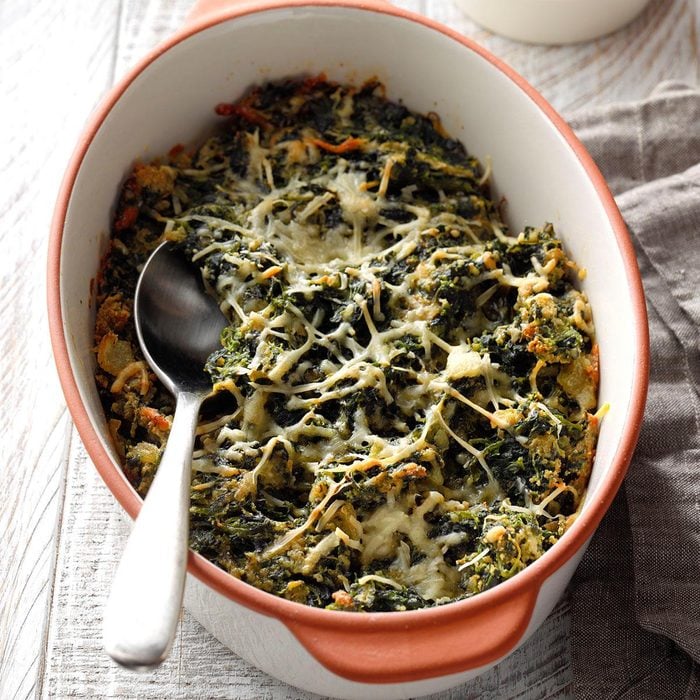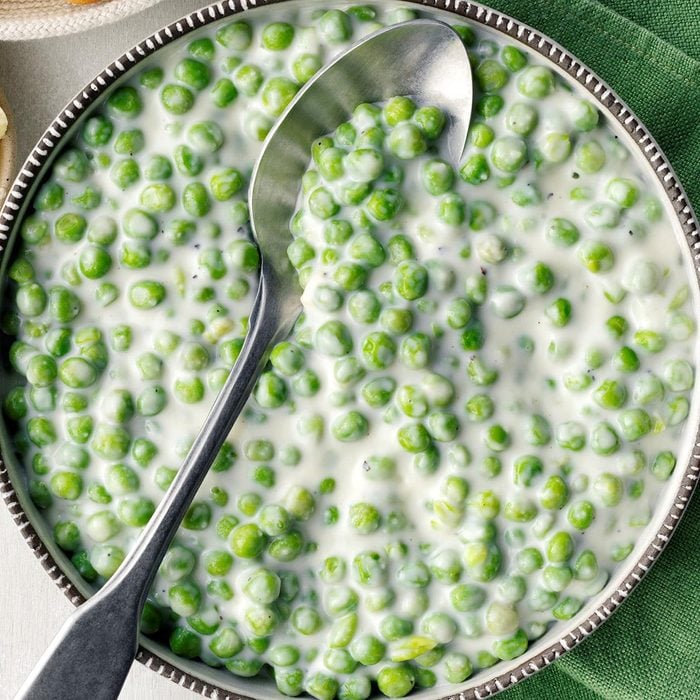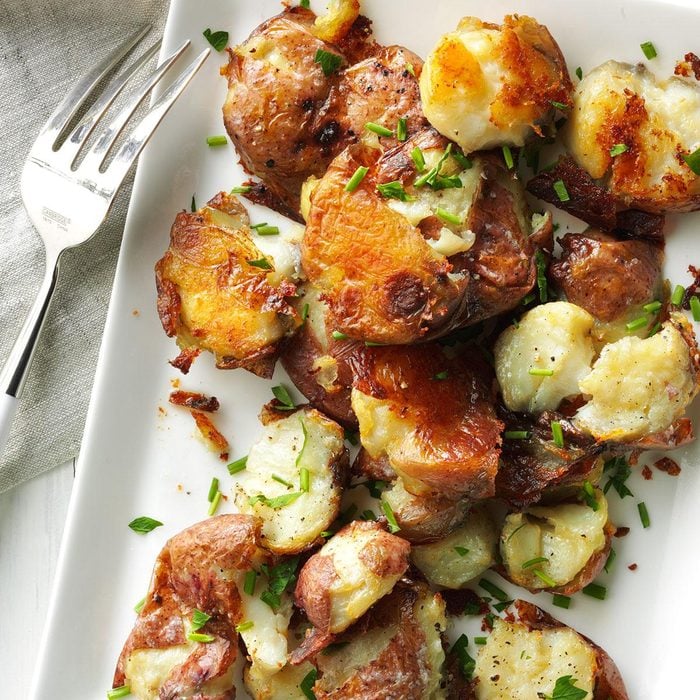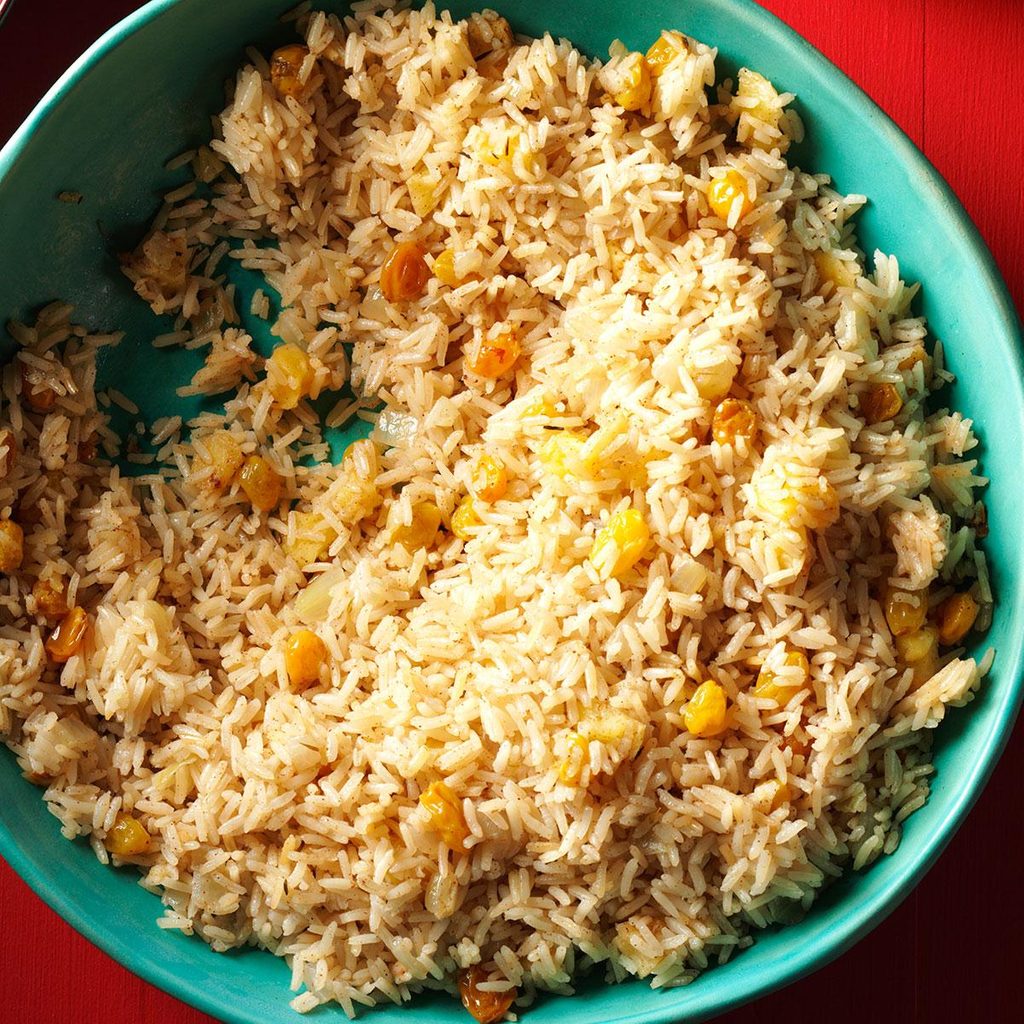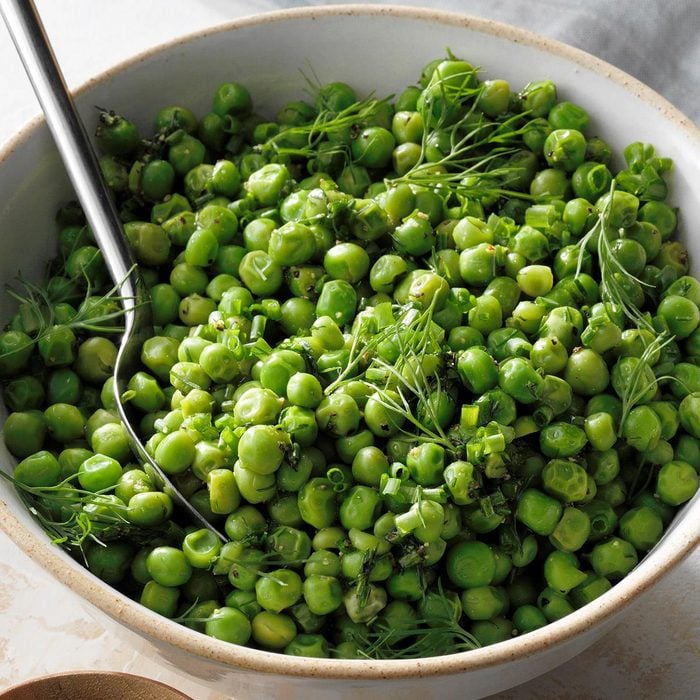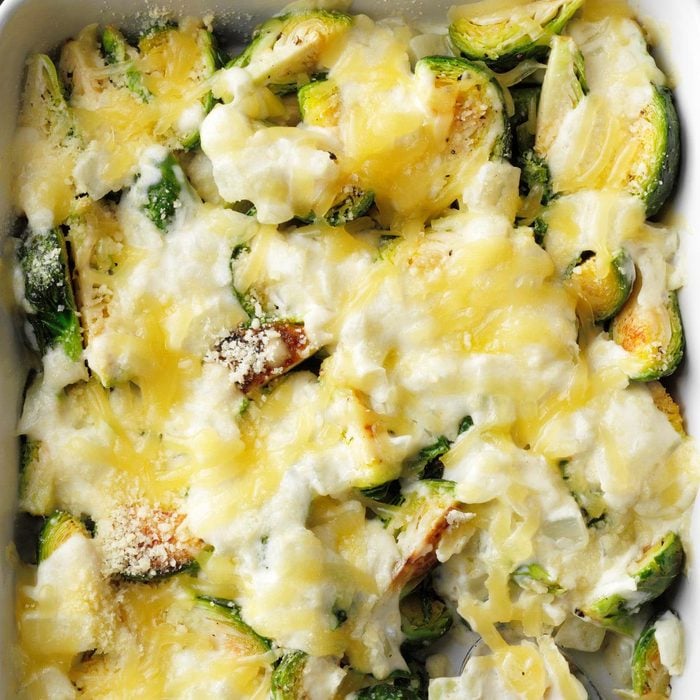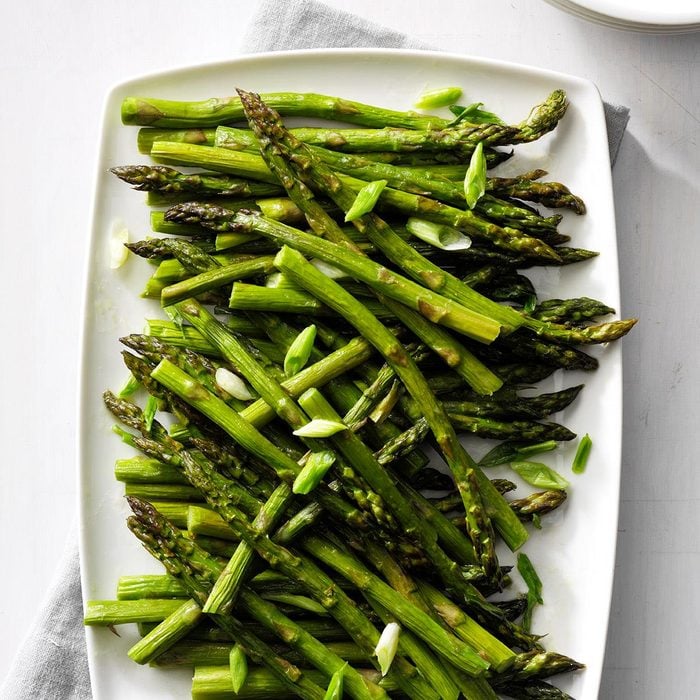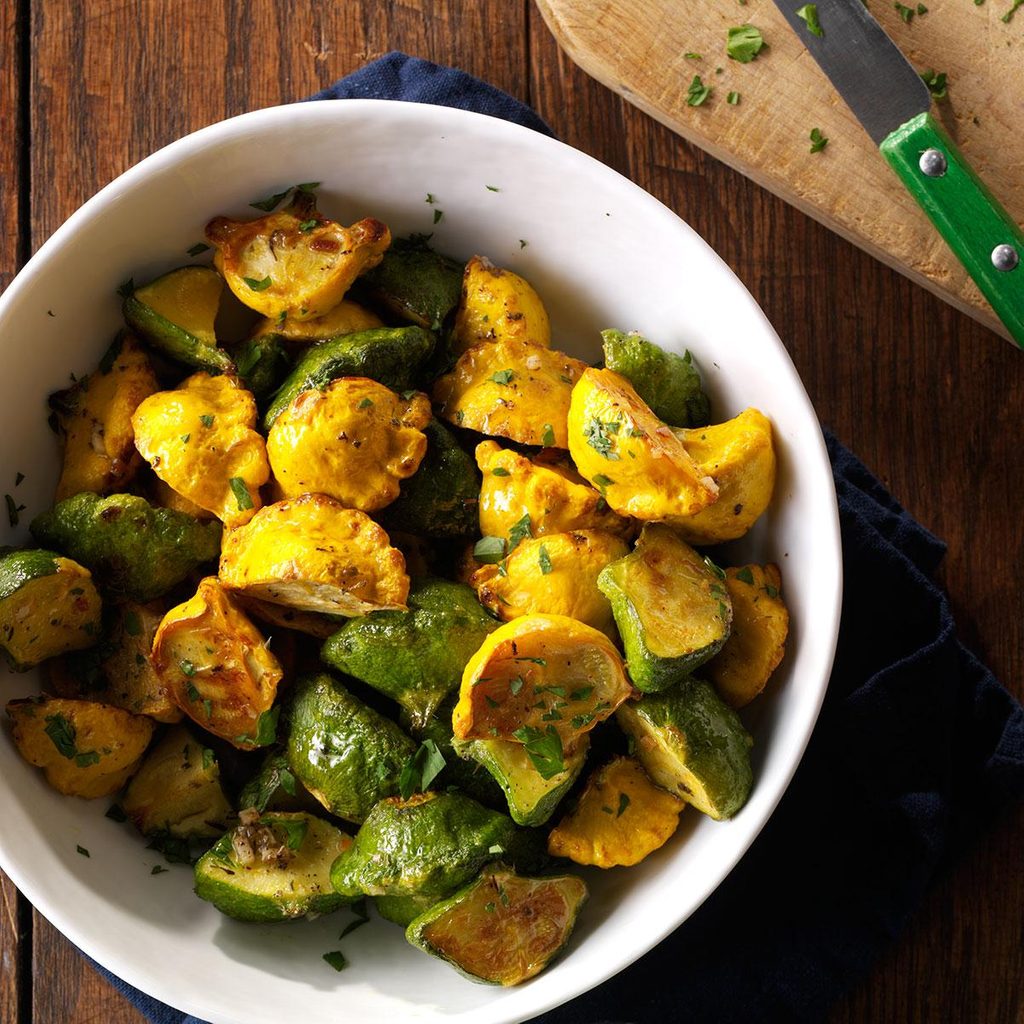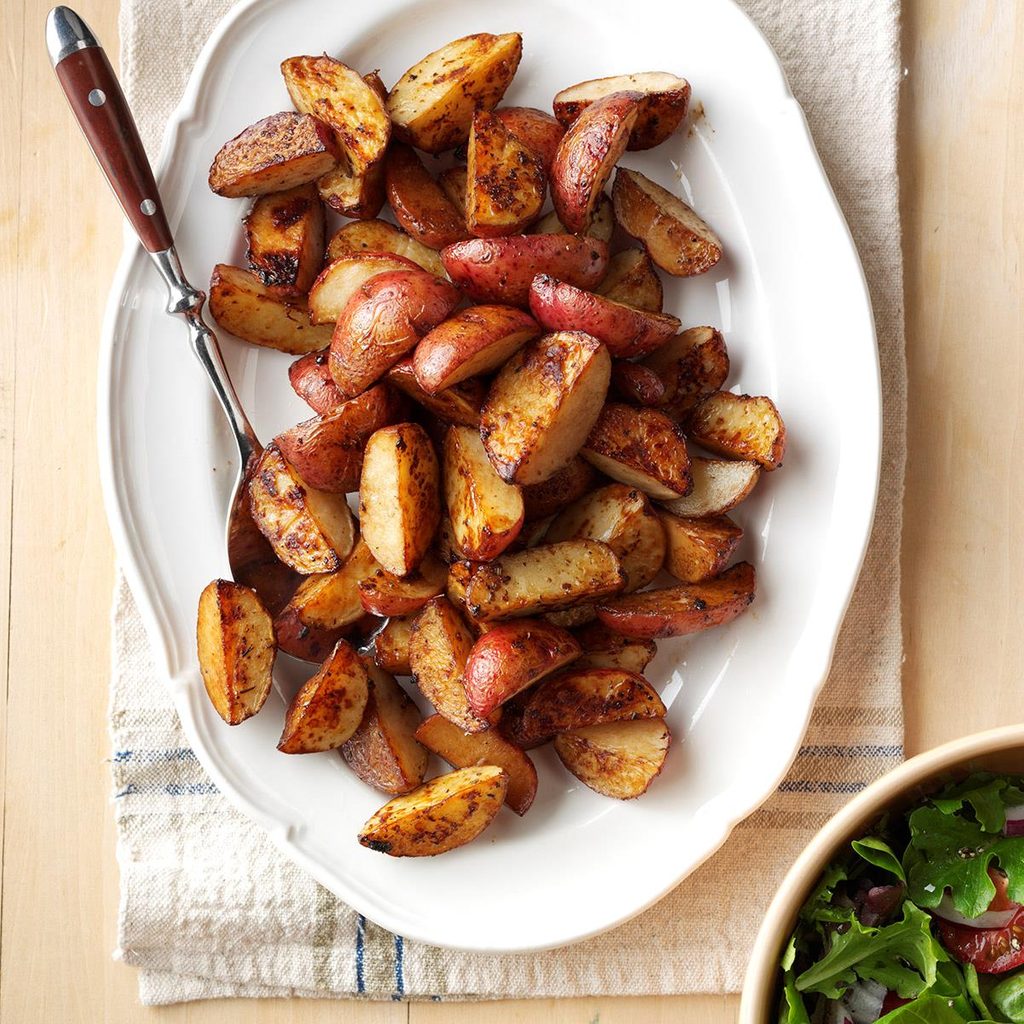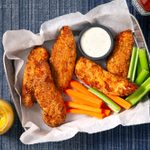ⓘ
You don’t have to grow up flinging fish at Pike Place to know just how wonderful salmon can be. Its tender-fatty flavor practically melts in your mouth and its rosy color looks bright on any plate. While salmon tastes delicious on its own, it’s a great base for marinades, glazes and sauces, which win over even the pickiest eaters who claim not to like fish.
Because it’s so versatile, our favorite salmon recipes use many different cooking methods and techniques. In this guide, we’ll teach you the tips you need to know for how to choose, prep and cook salmon like a pro.
How to Buy the Best Salmon
Cuts of Salmon
 Sydney Watson/Taste of Home
Sydney Watson/Taste of Home
You’ll find a few popular cuts of salmon at the fish counter of most supermarkets:
- Salmon steaks are horseshoe-like cuts taken crosswise from the fish. This salmon steak recipe is great to use for special-occasion dinners for a small group.
- Salmon fillets are simply smaller portions cut from salmon sides. They’re the most common cut of salmon and they can weigh anywhere from 4 to 8 ounces. We opt for salmon fillets for most of our weeknight dinner recipes as they’re quicker to cook and more convenient than larger cuts of fish.
- A side of salmon makes a statement if you’re cooking for a group. The cut is taken lengthwise from the whole fish and serves eight or more.
Farm-Raised vs. Wild-Caught
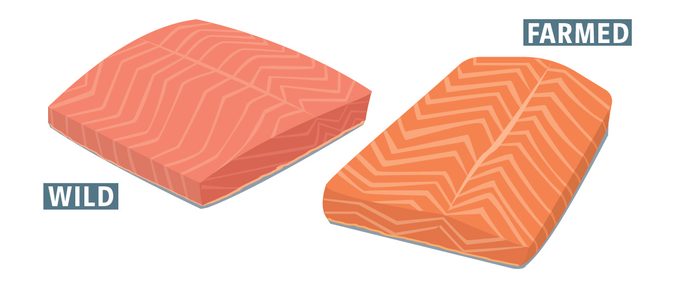 Sydney Watson/Taste of Home
Sydney Watson/Taste of Home
The environment from which salmon was sourced has a big impact on how the fish looks and tastes—and, inevitably, how much it costs. Here are some of the key differences between wild-caught and farm-raised salmon:
Wild-Caught
- Appears thin and lean
- Bold red-orange color
- Has few thin stripes of fat
- Can be pricey and hard to find
Farm-Raised
- Appears thicker and fattier
- Pale orange-pink color
- Has large visible stripes of fat
- Affordable and commonly available
While there are advantages to both wild-caught and farm-raised salmon, we like to shop for wild-caught salmon when we can. Depending on where you live, you may find a few different breeds of wild-caught salmon. These are likely from the Pacific and can include chinook (also known as king), chum or keta, coho and sockeye salmon. You can’t go wrong with any of them; all are suitable for the most common prep methods.
Editor’s note: If you can’t find wild-caught salmon at your local store, we recommend ordering from Sitka Salmon Shares. The seafood company operates boat-to-doorstep, working with small family fishermen who only catch what is sustainable. In any given year you’ll be able to try fresh cuts of king, keta, sockeye and coho salmon. “It can really open up your exposure to fish you might not have otherwise tried,” says Jennifer Zeigler, Deputy Editor of Country Woman.
Skin On vs. Skin Off
Can you eat salmon skin? Absolutely. We prefer to cook salmon with its skin on for most preparations, as the skin acts as a barrier from the direct heat. This helps keep the delicate meat tender. Not to mention, the skin becomes deliciously crispy when oiled up and exposed to heat.
The only time we recommend removing the skin from salmon is if you’re planning to poach it or cook it en papillote. These methods will result in soggy skin.
Learn even more about how to buy salmon.
How to Remove Pin Bones
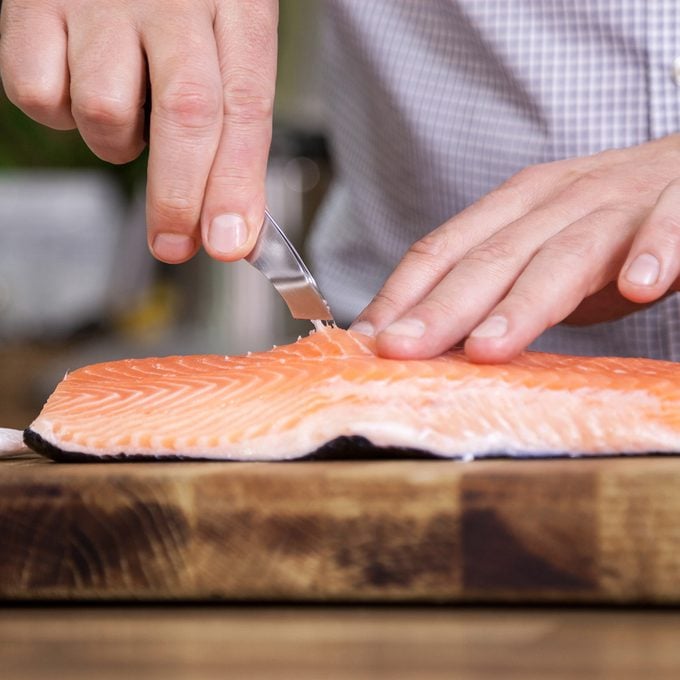 FotoCuisinette/iStock/Getty Images Plus
FotoCuisinette/iStock/Getty Images Plus
Pin bones are tiny hairlike bones that can make salmon fussy to eat. Most cuts of salmon have the pin bones already removed, but sometimes you’ll still find them in specialty cuts.
To check for pin bones, simply run your fingers up the length of the salmon. If you feel slight bumps, remove the bones with a pair of clean needlenose pliers or fish tweezers ($11.99). Grab hold of the bone, give it a wiggle and it’ll slide right out.
Tools for Cooking Salmon
You only need a few tools for cooking salmon. Our Test Kitchen recommends a thin, sturdy metal spatula like this fish turner ($14) that makes it easy to transfer fillets from one surface to the next. A cast-iron skillet ($24) will also come in handy for our favorite oven-roasted salmon recipe. Lastly, a set of plastic squeeze bottles ($10) are always nice to have on hand to apply oil directly onto fish or into the pan.
How to Know When Salmon Is Done
An easy way to test when salmon has finished cooking is to use the flake test: Press down on the top of the fillet with a fork. If the salmon flakes, or separates along the lines of its flesh, it’s finished cooking. Its flesh should look opaque.
You can also test salmon with a food thermometer. The USDA recommends salmon has an internal temperature of 145°F when the thermometer is inserted into the thickest part of the fish. However, due to an effect called carryover cooking, we recommend pulling salmon off heat around 115° to 125°F. It will rise to a food-safe temperature before it reaches your plate.
Wondering what the white stuff is that sometimes comes out of salmon? It’s called albumin. When salmon is overcooked, this milky protein will begin to seep out and coagulate on the surface of the fish. While it might not be the most attractive, it’s perfectly safe to eat.
You don’t want to make these common salmon mistakes.
How to Cook Salmon
How to Bake Salmon
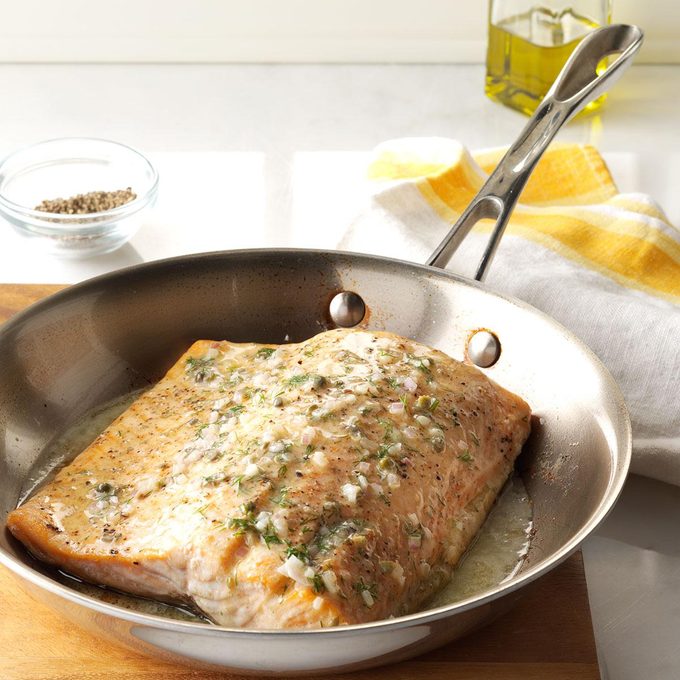 Taste of Home
Taste of Home
There are many baked salmon recipes, including this oven-roasted salmon that was developed by staffer Jeanne Ambrose. It’s a great recipe to know by heart. You can bake salmon in foil or even try our cast iron salmon for a perfectly crispy skin.
Directions
- Place an oven-proof skillet into a cold oven and heat to 450ºF.
- Brush a center-cut salmon fillet (1-1/2 pounds) with olive oil and sprinkle with the salt and pepper. Remove the pan from the oven add the fillet skin side down—this is the key to crispy-delicious skin!
- With the salmon in place, return the skillet to the oven and cook uncovered for 14 to 18 minutes, or until a thermometer reads 125ºF. Remove from the pan and cut the salmon into single-serving sizes. Next, check out this simple pan-fried salmon is perfect for weeknight meals
Recipes for Baked Salmon
How to Pan-Sear Salmon
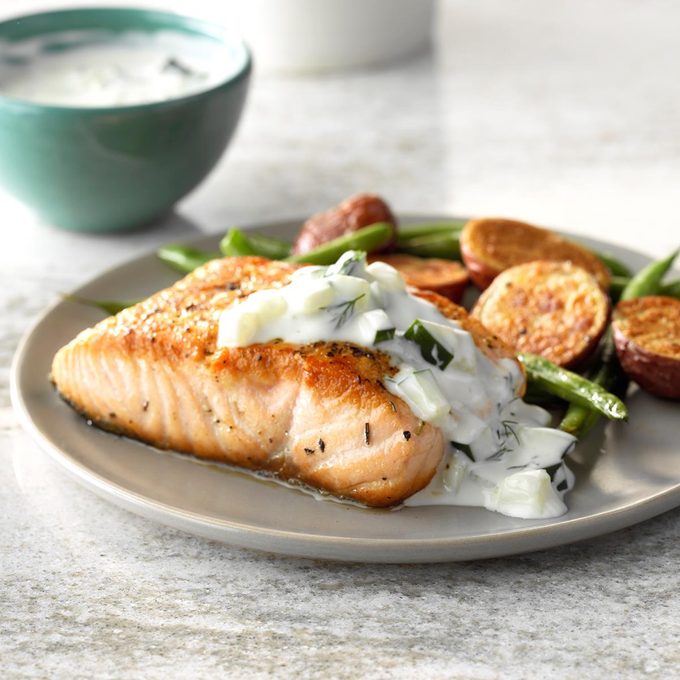 Taste of Home
Taste of Home
Pan-seared salmon a simple dish that doesn’t heat up the kitchen. For a fresh take, we love slathering it with creamy dill sauce like this pan-seared salmon recipe submitted by Angela Spengler from Tampa, Florida.
Directions
- In a large skillet, heat oil over medium-high heat.
- Season salmon and place in skillet, skin side down. Reduce heat to medium. Cook until fish just begins to flake easily with a fork, about 5 minutes on each side. Keep an eye on the salmon here; if the skillet gets too hot, the outside of the salmon will get too dark before it’s cooked through.
Recipes for Pan-Seared Salmon
How to Grill Salmon
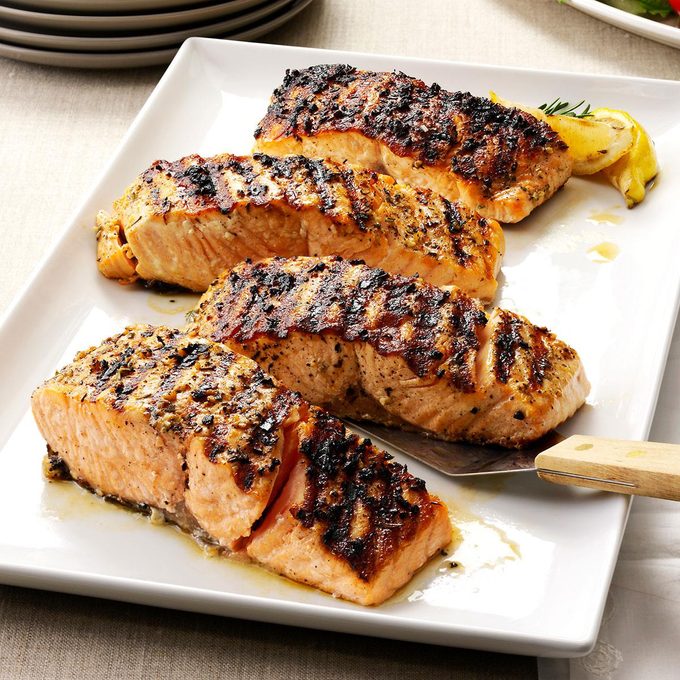 Taste of Home
Taste of Home
Cooking salmon on the grill is just about the only way to get a good charred crust. Glazes and marinades like you’ll find in this recipe for grilled salmon ensure that your dish is loaded with flavor. To keep fish from sticking, ensure your grill grates are clean and well-oiled.
Directions
- Marinate or season salmon. Moisten a paper towel with cooking oil; using long-handled tongs, rub on grill rack to coat lightly.
- Place salmon on grill rack, skin side up. Grill, covered, over medium heat for 4 minutes. Turn; grill 3-6 minutes longer or until fish just begins to flake easily with a fork.
Recipes for Grilled Salmon
How to Broil Salmon
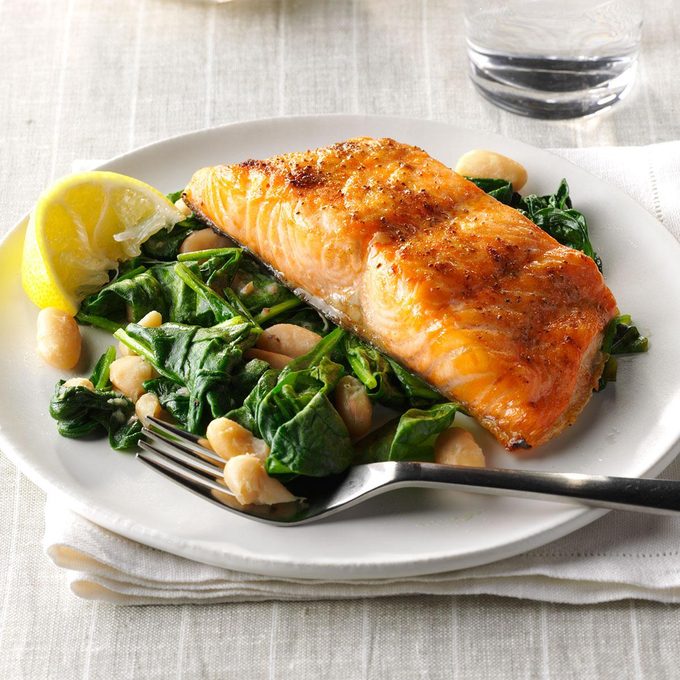 Salmon with Spinach and White Beans
Salmon with Spinach and White Beans
While most people bake fish in the oven, we love using the broiler instead. A broiler basically works like a reverse grill, cooking your fish from the top down. It’s super easy to pull off, and you can get away with using little to no oil because the fish won’t stick. We especially love this broiled recipe for Salmon with Spinach & White Beans from Mary Ellen Hofstetter of Brentwood, Tennessee.
Directions
- Preheat the broiler and position the top rack so it’s about six inches from the heating element.
- Place salmon fillets, skin side down, on a foil-lined baking sheet. Cover with a light layer of cooking spray and season with salt and pepper.
- Slide the baking sheet underneath the broiler. Cook for about 7 to 10 minutes.
Recipes for Broiled Salmon
How to Poach Salmon
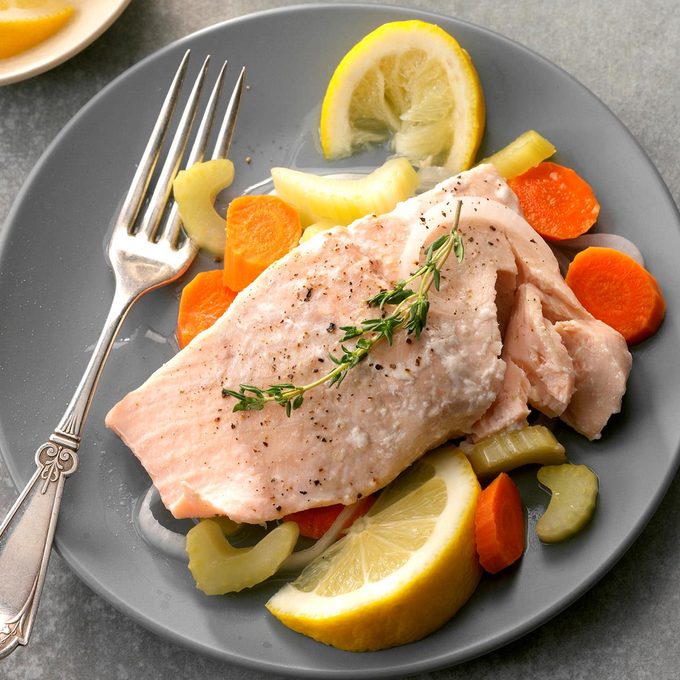 Taste of Home
Taste of Home
Poaching sounds fancy, but it’s really just a gentle cooking method that uses a warm, flavorful liquid to cook your fish. We love the aromatics called for in this Simple Poached Salmon recipe shared by Erin Chilcoat of Central Islip, New York. It’s super healthy and shockingly easy to pull off. (Psst: You can also make this recipe in the pressure cooker.)
Directions
- In a large saucepan, combine water with a blend of seasonings and aromatics. (We recommend 3 cups water, 1 cup wine, 1 small sliced onion, parsley, peppercorn, plus a 1/4 teaspoon of salt.) Add the salmon in a single layer to the pan. If the liquid does not cover the fillets, add extra water until it does.
- Bring the saucepan to a simmer over medium heat. When it’s just below simmering (about 180°F), reduce the heat to low. Continue to cook the salmon for 15 to 20 minutes, until it flakes easily with a fork. Remove the salmon to a plate and let it rest before serving.
How to Cook Salmon in a Pouch
ⓘ
Also called salmon en papillote, this traditional cooking method traps steam inside parchment paper, resulting in a perfectly moist piece of fish. It’s a great compromise between the texture of baked and poached fish, and there are almost no dishes to clean when you’re finished cooking!
What’s more, you can even cook a simple veggie inside the packet, too, as we do in this recipe for Citrus Salmon en Papillote from Dahlia Abrams of Detroit, Michigan. To serve, allow your guests to open the packets at the table, or you can open the paper and plate the fish ahead of time. Either way, open the packets carefully to allow the steam to escape.
Directions
- Preheat the oven to 425°F. Cut four pieces of parchment paper into 16- by 12-inch rectangles. Fold the paper in half and, using a pair of scissors, cut out a large heart shape, using up as much space on the paper as you can. Open the heart and arrange two lemon slices on the right side of the fold on each piece of paper. Place a salmon fillet on top of the lemon slices and season it with salt and pepper. Finish the packets by adding desired herbs or vegetables and a drizzle of lemon juice.
- Fold the left side of the heart over top of the salmon. Starting at the top of the heart, fold the edges down to create an overlapping crimped pattern. When you get down to the bottom, twist the final fold under the packet to secure it. You can also use a paperclip to hold it into place, if you like.
- Place the packets on a sheet tray and slice it into the preheated oven. Bake the salmon for 12 to 15 minutes, until it flakes easily with a fork.
How Long Does Salmon Last?
Uncooked salmon lasts for 1 to 2 days in the fridge and 6 to 8 months in the freezer. To store salmon, wrap in a tight layer of plastic wrap followed by a layer of aluminum foil. When freezing, place wrapped salmon in a freezer-safe storage bag, removing as much air as possible. Mark the bag and label it with its use-by date. To thaw salmon, place in the fridge overnight.
Cooked salmon can last in the fridge for 2 to 3 days, but that it may expire sooner depending on the freshness of the fish when it was first cooked. Always check for signs of spoilage before serving. If your salmon has a slimy texture, unpleasant smell or milky discoloration it should be tossed.
The Best Sauce for Salmon
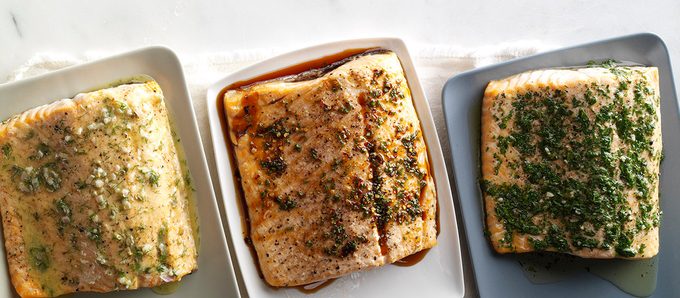 Taste of Home
Taste of Home
While salmon tastes great on its own, a classic way to dress up this tender fish is to spoon on a flavorful sauce. Here are a few simple sauces to start with:
- Gremolata: In a small bowl, mix 1/4 cup minced fresh parsley, 2 tablespoons olive oil, 1 tablespoon lemon juice, 1 minced garlic clove, 1 teaspoon grated lemon peel, 1/2 teaspoon salt and 1/4 teaspoon pepper.
- Dill and Caper Butter: In a small bowl, mix 1/4 cup softened butter, 1 tablespoon minced shallot, 1 tablespoon minced fresh dill, 1 teaspoon Dijon mustard and 1 teaspoon chopped capers.
- Maple Soy Glaze: In a small bowl, mix 1/4 cup maple syrup, 2 tablespoons soy sauce, 1 minced green onion, 1/2 teaspoon grated fresh ginger and 1/4 teaspoon red pepper flakes.
What to Serve with Salmon
Already have a great salmon recipe, but need another dish to make your meal complete? Choosing the best side dishes for salmon is easy. Popular choices include cooked vegetables like asparagus or green beans and starches like potatoes or rice. But don’t convention keep you from switching it up. Serve salmon with pearled couscous or a simple spinach salad for a healthy take. If you have a simply seasoned salmon fillet, opt for bold-flavored sides like pickled cucumber or brown-sugar glazed carrots.
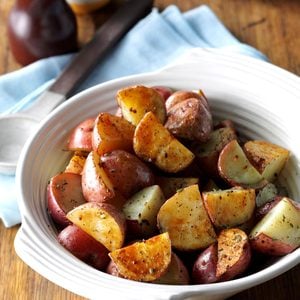 Taste of Home
Red Roasted Potatoes
Taste of Home
Red Roasted Potatoes
Fragrant rosemary—either fresh or dried—gives these roasted red potatoes a distinctive and subtle taste. This dish is simple to prepare yet elegant in color and flavor. It's one of my favorite sides for salmon. —Margie Wampler, Butler, Pennsylvania
Go to Recipe
Slow-Cooker Spinach & RiceI started making this in the slow cooker to save oven space during the holidays. It's so convenient, I no longer reserve it for special occasions! Serve it as a side for salmon to make a full meal. —Erica Polly, Sun Prairie, Wisconsin
Balsamic Purple PotatoesI volunteered at a local organic farm in exchange for fresh produce, and I was given purple potatoes. I wanted to cook something new and use herbs from our garden. Coming from the Midwest, adding vinegar to potato recipes has always been a hit, especially with fries! —Kristin Schultz, Manor, Texas
Pea Risotto with LemonIf you're looking for something to serve with salmon, your search is over! Lemon adds a refreshing taste to this lovely pea risotto dish that's perfect for spring. —Sue Dannahower, Fort Pierce, Florida
Rosemary Roasted Potatoes and AsparagusShowcase asparagus when you dress it in fresh rosemary and red potatoes for an earthy counterpoint to the fresh, green spears. Add minced garlic and you get a gorgeous, flavorful side for salmon. —Trisha Kruse, Eagle, Idaho
White Beans and SpinachThis skillet side is a variation of a recipe I received from my Italian mother. I've prepared spinach this way for years—because my children eat it happily! —Lucia Johnson, Massena, New York
Brown Rice and VegetablesThis filling rice dish, full of big chunks of butternut squash and sweet potatoes, is a standout combination of sweet and savory flavors perfect as a side for salmon. —Taste of Home Test Kitchen
Roasted Asparagus With ThymeThis is good-for-you spring-time side dish is so easy to prepare, yet the simply seasoned spears look appealing enough to serve guests or take to carry-in dinner.
-Sharon Leno
Keansburg, New Jersey
Herb-Buttered Baby CarrotsThe herb butter can be used for everything from vegetables to roast chicken, turkey, game hens—let your imagination be your guide. We love it on baby carrots served as a side for salmon. —Sandra Corey, Caldwell, Idaho
Grilled Peach, Rice & Arugula SaladThis hearty salad was created when I needed to clear out some leftovers from the fridge—and it became an instant hit! The grilled peaches are the ultimate "tastes like summer" salad booster. —Lauren Wyler, Dripping Springs, Texas
Confetti QuinoaIf you have never tried quinoa, start with my easy side, brimming with colorful veggies. I serve it with orange-glazed chicken or as a side for salmon. —Kim Ciepluch, Kenosha, Wisconsin
Tuscan-Style Roasted AsparagusThis is especially wonderful when locally grown asparagus is in season, and it's so easy for celebrations because you can serve it hot or cold. This is how to bake asparagus. —Jannine Fisk, Malden, Massachusetts
Flavorful Green RiceNow this is what to serve with salmon! Green onions and parsley give this rice its name, but the appealing flavor is what makes it memorable. —Karin Bailey, Golden, Colorado
Fruit & Spinach SaladThe combination of sweet fruit and salty feta cheese makes this salad a winner. —Virginia Dack, Asheville, North Carolina
Kale Quinoa SaladHere's a holiday side dish you can feel good about serving. Kale packs a mighty punch of vitamins, while quinoa delivers a hearty serving of protein. Best of all, the flavor of this kale quinoa salad can't be beat! —Lisa Warren, Washington, DC
Zucchini PastaThe taste of this rich and creamy pasta with zucchini will have people convinced it's not low-fat, but it is! Garlicky and fresh-flavored, this will be a hit. It's one of the best sides for salmon. —Maria Regakis, Saugus, Massachusetts
Brussels Sprouts with GarlicThese Brussels sprouts are special enough for company—I like to serve them for Thanksgiving dinner. If you can't find fresh sprouts, try using the frozen one. —Myra Innes, Auburn, Kansas
Roasted Greek Potatoes with Feta CheeseLemony Greek potatoes are a traditional side for salmon, grilled chicken or steak. When they come out of the oven, we top with feta for a little melty goodness. —Arge Salvatori, Little Ferry, New Jersey
Wilted Curly EndiveThis warm curly endive salad is a deliciously different way to serve lettuce. Unlike other wilted versions, this one is not sweet. Vinegar and bacon give it old-fashioned savory goodness. —Chere Bell, Colorado Springs, Colorado
Vegetable Barley BakeForget the potatoes and rice, and consider this change-of-pace dinner accompaniment. Wholesome barley makes for a heart-smart dish that complements just about any main course and other sides, too. —Shirley Doyle, Mount Prospect, Illinois
Old-Fashioned Green BeansMom would prepare homegrown green beans using this recipe and, boy, did they ever taste good! The bacon provides rich flavor and the brown sugar a touch of sweetness. This is one irresistible side for salmon. —Willa Govoro, St. Clair, Missouri
Spinach Blueberry SaladBlueberries are a fun surprise in this salad. I received the recipe from a co-worker's wife, and it's become one of my favorites. —Heidi Gilleland, Lees Summit, Missouri
Glazed Baby CarrotsFor a zippy side for salmon, try this recipe. These brown sugar-glazed carrots come together in no time at all. —Anita Foster, Fairmount, Georgia
Zucchini in Dill Cream SauceMy husband and I were dairy farmers until we retired, so I always use fresh, real dairy products in my recipes. This creamy sauce combines all our favorite foods! —Josephine Vanden Heuvel, Hart, Michigan
Savory String BeansI love making this dish when I can pick the beans right out of the garden and put them into the pot. The fresh taste is unbeatable. I've also made it with beans purchased at the store. Either way, you'll find this recipe a winner. There's no need for any extra seasonings at the table. —Ina Reed, Kingman, Arizona
Vegetable and Barley PilafHearty, colorful, easy and fast were the reviews we gave this good-for-you dish. Barley has a healthy amount of soluble fiber, which aids digestion. And it can help to lower cholesterol too! You can easily substitute other fresh veggies you have on hand. —Jesse Klausmeier, Burbank, California
Roasted Rosemary CauliflowerRoasting the cauliflower really brings out its flavor in this side for salmon. Even folks who aren't cauliflower lovers like it this way. —Joann Fritzler, Belen, New Mexico
Light Strawberry-Spinach SaladThis strawberry-spinach salad makes a wonderful light summer meal or side for salmon or chicken. All of the flavors and colors complement one another very nicely. Farmers here in Washington grow a lot of strawberries, and they're the sweetest ones I've ever tasted. I'm always looking for new and different ways to use them. —Perlene Hoekema, Lynden, Washington
Barley RisottoLow in fat, but high in fiber, this delicious barley risotto puts a twist on the typical dish. With its nutty undertones, barley provides the perfect backdrop for lemon and parsley. —Taste of Home Test Kitchen, Milwaukee, Wisconsin
Sauteed ZucchiniI've found that this flavorful sauteed zucchini complements almost any main course, from chicken to fish. If you like, use half yellow summer squash for a colorful variation on classic zucchini recipes. —Teresa Kraus, Cortez, Colorado
Rosemary Potatoes with Caramelized OnionsRoasted potatoes are amazing. Add some rosemary and caramelized onions and they are over-the-top delicious! —Mary Jones, Athens, Ohio
Oven-Baked AsparagusI like to use recipes that call for fresh produce I've grown in my garden. Here's a simple way to make baked asparagus to bring out the flavor while maintaining that bright green color. —Robert Foust, Indianapolis, Indiana
Sweet CarrotsHere's a flavorful way to dress up carrots without a lot of fuss. Simply steam the good-for-you veggies, then season with butter, brown sugar, vinegar and a sprinkling of chives. The carrots are not only colorful, but they're tasty, too. —Taste of Home Test Kitchen
Nutty Barley BakeWhen I started bringing this distinctive dish to holiday dinners, a lot of people had never seen barley in anything but soup. They have since dubbed me "the barley lady", and now I wouldn't dare bring anything this dish. Even if I double the recipe, I come home with an empty pan.
-Renate Crump, Los Angeles, California
Pressure-Cooker Green BeansFree up room on your stovetop when you're cooking for company and make these easy pressure-cooked green beans. Mix and match with your favorite herbs and spices. It really does only take 1 minute to get crisp-tender green beans. The recipe easily cuts in half to serve four on weeknights. —Peggy Woodward, Shullsburg, Wisconsin
Baked Vidalia OnionsVidalia onion recipes are some of my favorites to whip up. Served as a side for salmon, these tender onions are a nice change of pace. Folks find it a fun and flavorful dish. —Norma Durham, Rogersville, Tennessee
Nectarine Arugula SaladHere's a summer salad that brightens any supper. The homemade dressing with a hint of berries is perfect with arugula, nectarines and blue cheese. —Christine Laba, Arlington, Virginia
Lemon Couscous with BroccoliI combined two recipes to create this side with broccoli and pasta. The splash of lemon adds nice flavor. Instead of toasted almonds, you could also sprinkle servings with grated Parmesan cheese. —Beth Dauenhauer, Pueblo, Colorado
Pepper Parmesan BeansA colorful mixture of peppers and green beans gets an Italian treatment with basil and Parmesan cheese in this delightful vegetable dish. The garlic adds a savory zip. —Marian Platt, Sequim, Washington
Zesty Sugar Snap PeasLemon pepper and garlic make these crisp-tender sugar snap peas flavorful and a nice side for salmon. You'll come to rely on this six-ingredient recipe. —Taste of Home Test Kitchen
Oven Parmesan ChipsMy husband and I avoid fried foods, but potatoes are part of our menu almost every day. These delectable sliced potatoes get nice and crispy and give our meals a likable lift. —Mary Lou Kelly, Scottdale, Pennsylvania
Spinach Salad with Raspberries & Candied WalnutsI created a bright spinach salad with raspberries for a big family dinner. Even those who don't normally like spinach change their minds after the first bite. —Robert Aucelluzzo, Simi Valley, California
Mediterranean Bulgur BowlYou can also transform this tasty bowl into an Italian version with mozzarella, pesto, tomatoes, spinach and basil. —Renata Smith, Brookline, Massachusetts
Grilled Peppers and ZucchiniThis versatile side dish is so simple and quick that I had to share it. Grilling the colorful veggies in a foil packet means one less dish to wash, but I sometimes stir-friy the mixture on the stovetop. —Karen Anderson, Fair Oaks, California
Thyme Green Beans with AlmondsThyme is a lovely addition to this classic vegetable side dish. The recipe is a snap to make for family, yet special enough to serve guests. —Kenna Baber, Rochester, Minnesota
Parmesan AsparagusNothing could be more simple than this side dish. Since it has just four ingredients, I assemble it in no time, then pop it into the oven for about 15 minutes. It turns out perfect every time. —Mary Ann Marino, West Pittsburgh, Pennsylvania
Brussels Sprouts & Quinoa SaladWith Brussels sprouts for the green and cranberries for the red, I make a cheery Christmastime salad. Refreshing and versatile, it works with any kind of nut or dried fruit. —Cameron Stell, Los Angeles, California
Pea Pod Carrot MedleyWe grow pea pods, and I wanted to use them in something other than stir-fries. This fit the bill! I've carried it to church potlucks and received compliments on its pretty orange glaze and fresh taste. —Josie Smith, Winamac, Indiana
Herbed Baked SpinachParmesan cheese and garlic liven up this spinach dish, which is a good side for salmon and casseroles. Sometimes, I use broccoli as a spinach substitute. It's equally delicious.
Creamed PeasI can still taste these wonderful creamed peas in Mama's delicious white sauce. Our food was pretty plain during the week, so I thought this white sauce made the peas "extra fancy" and fitting for a Sunday meal.
Crispy Smashed PotatoesGolden brown and buttery, these crispy smashed potatoes live up to their tantalizing name. A sprinkle of fresh herbs when they’re hot out of the oven maximizes the flavor…and the pretty. —Althea Dye, Howard, Ohio
Rice Pilaf with Apples & RaisinsI love making bulgar pilaf with apricots. So glad I tried it with dried apples and golden raisins! —Elizabeth Dumont, Madison, Mississippi
Dill & Chive PeasGrowing my own vegetables and herbs helps keep things fresh in the kitchen, but frozen peas make this side is a breeze to prepare. —Tanna Richard, Cedar Rapids, Iowa
Brussels Sprouts GratinThis side for salmon will likely become your family’s favorite way to enjoy Brussels sprouts. It’s creamy, savory and delicious. —Kevin Lieberman, Oklahoma City, Oklahoma
Oven-Roasted AsparagusAsparagus never tasted so good! Simply seasoned with butter and green onions, they taste fresh and keep their bright green color, too. They're so good, you might want to make extra. This is how to cook asparagus in the oven. —Jody Fisher, Stewartstown, Pennsylvania
Garlic-Herb Pattypan SquashThe first time I grew a garden, I harvested summer squash and cooked it with garlic and herbs. When choosing what to serve with salmon, pattypan squash is a creative twist. —Kaycee Mason, Siloam Springs, Arkansas
Roasted Balsamic Red PotatoesWhen I found a potato recipe that called for vinegar, I was intrigued. But without all the ingredients on hand, I had to improvise and gave it a whirl using Italian seasoning and balsamic vinegar. It was fantastic! —Lisa M. Varner, El Paso, TX











